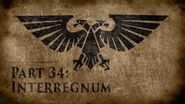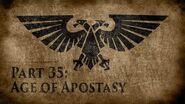"There is no truth in flesh, only betrayal."
"There is no strength in flesh, only weakness."
"There is no constancy in flesh, only decay."
"There is no certainty in flesh but death."
- — Credo Omnissiah
The Adeptus Mechanicus is the official Imperial name within the Adeptus Terra for the Cult Mechanicus or Cult of the Machine based on Mars which provides the Imperium with its scientists, engineers and technicians.
The tech-adepts of the Mechanicus are the primary keepers of what is viewed as sacred wisdom, a privileged caste of Tech-priests who jealously guard the knowledge required to maintain and construct much of the Imperium's advanced technology.
In ancient times, before the current Age of the Imperium officially began following the end of the Horus Heresy, the Adeptus Mechanicus was instead called the Mechanicum. The Adeptus Mechanicus was formally separated from the larger Mechanicum of Mars by order of the Council of Terra in 012.M31. This occurred after the Red Planet had fallen to the control of the Hereteks who represented the Traitor faction of the Mechanicum loyal to the Warmaster Horus later called the "Dark Mechanicum."
The Mechanicus acknowledge the Emperor of Mankind as the ruler of the Imperium of Man, but not the religious truth of the Imperial Cult or the Ecclesiarchy, and are granted an unusual amount of political and religious autonomy within the Imperium's structure, a role protected by the ancient Treaty of Mars. The Mechanicus essentially maintains an empire-within-an-empire in Imperial space, and its interests usually, but not always, coincide with those of the wider Imperium.
Instead of the Imperial Creed, the servants of the Mechanicus follow their own dark and mysterious scriptures and worship the strange deity they call the Machine God or the "Omnissiah."
As part of this faith, the Adeptus Mechanicus believes knowledge is the true manifestation of divinity in the universe, and all creatures and artefacts that embody knowledge are holy because of it. The Emperor is the supreme object of worship for the servants of the Mechanicus, for He is the living avatar of the Machine God that is the Omnissiah.
The Emperor was recognised by the ancient Mechanicum as the fulfillment of the prophecy of the coming of the Omnissiah because He comprehends so much, and understands more about the true nature of reality than any other being in existence.
The Tech-priests of the Adeptus Mechanicus also regard organic flesh as weak and view the removal and replacement of biological tissue with mechanical, bionic parts as sacred. Most elder Tech-priests have few organic parts left and eventually become more machine than man.
The Adeptus Mechanicus is based on Mars, the very first Forge World of the Imperium, and they are the sole rulers of the Red Planet. They provide the technical and scientific experts of the Imperium and field armies of massive Titans, Questor Mechanicus Knights, Electro-priests, Skitarii and Combat Servitors.
History

Departmento Cartigraphicae galaxy map depicting the bastions of the Machine God, ca. 999.M41
The Adeptus Mechanicus is the one Imperial adepta that as the Cult Mechanicus actually predates the Imperium of Man itself, and was known originally as the Mechanicum of Mars. Though the Adeptus Mechanicus was formally integrated into the Imperium by the Treaty of Mars (known as the Treaty of Olympus Mons to the Mechanicum) over 10,000 Terran years before the "present" of the 41st Millennium at the dawn of the Emperor's Great Crusade to reunite Mankind in ca. 800.M30, it retains an unparalleled degree of autonomy from the rest of the Adeptus Terra for an Imperial Adepta.

The locations of the surviving Forge Worlds and Mechanicus Knight Worlds after the formation of the Great Rift in 999.M41
This autonomy was guaranteed to the Mechanicus in the Treaty of Mars to provide the Tech-priests with immunity to the dictates of the atheistic Imperial Truth and to allow the Mechanicus to continue to exercise sovereignty over all of the Forge Worlds it had settled across the galaxy during the Age of Strife. In return, the Mechanicus agreed to aid in the construction of the massive fleets and the provision of the technical aid necessary for the Imperium of Man to launch the Great Crusade.
Whereas nearly all the citizens of the Imperium observe the tenets of one of the various sects of the Imperial Cult that worships the Emperor of Mankind as the God-Emperor, the Adeptus Mechanicus is virtually synonymous with the Cult Mechanicus, another faith that could easily be considered heretical by the rest of the Imperium if the Adeptus Mechanicus was not essential to the survival of the Imperium and if the Tech-priests had not proven their loyalty to the Emperor in countless ways.
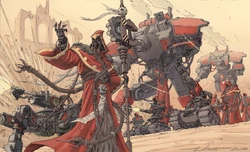
Mechanicus Tech-priest leading a Legio Cybernetica Maniple during the Great Crusade
The Adeptus Mechanicus is vitally important to Humanity because the Imperium, despite its technologically advanced state, has a very limited scientific knowledge of how its technology actually functions. This has only reinforced the prevailing Imperial view that the building and use of advanced machinery is almost a magical or religious act, fraught with ritual and inviolable instructions.
The Adeptus Mechanicus, with its inherent understanding of the Machine Spirit and the Machine God, has a near-monopoly on Standard Template Construct (STC) designs and other advanced Imperial technological knowledge. As a result, the Mechanicus wields a tremendous amount of power in the Imperium as the primary manufacturer, maintainer and repairer of everything from basic farming equipment to interstellar warships.
Mars
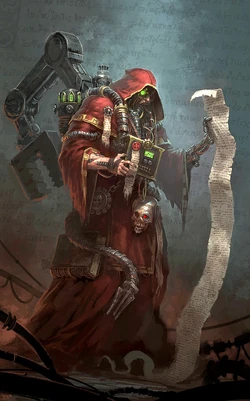
Adeptus Mechanicus Tech-priest exploring the mysteries of the Cult Mechanicus
The birthplace of the Adeptus Mechanicus was the ancient Forge World of Mars. Mars was colonised very early in human history, long before the start of even the Dark Age of Technology, and developed a society different from Terra both culturally and in terms of technological advancement. The arid, rusty surface of Mars was terraformed, and under a man-made oxygen-nitrogen atmosphere, the Martian colony flourished, though it remained politically independent from Terra. When the era of human interstellar colonisation began, both Terra and Mars served as the co-equal mother worlds of countless new human colonies across the galaxy.
During the Dark Age of Technology, the two empires of Terra and Mars co-existed under the aegis of the decentralised human interstellar government of that era, to the mutual benefit of both. At the height of its splendour during that era, and even later in the anarchic Age of Strife, Mars despatched hundreds of colony fleets into the void. Many perished in the terrible Warp Storms that engulfed the galaxy at that time before the birth of the Chaos God Slaanesh, but others survived or made their way forward at sublight speeds in realspace. Those who did founded new Forge Worlds in the name of the Machine God and built on them a likeness of the great manufactorums and temples of their distant homeworld. These Forge Worlds also forged new empires for the Mechanicus among the feudal Knight Worlds and added their unique combat walkers, the Knights, to the Mechanicus' own powerful arsenal.
The onset of the Age of Strife brought an end to the glory and peace of the ancient interstellar human domain. Across the galaxy, Mankind suddenly turned upon itself as a new breed of Warp-attuned psykers emerged and Warp Storms engulfed the galaxy, rendering interstellar travel and communication dangerous to the point of impossibility. Civil war engulfed thousands of human worlds, even the twin human homeworlds of Terra and Mars.
Many warring factions vied for power on Mars and waged a brutal civil conflict using arcane and unimaginably destructive weaponry, including psychic abilities. The carefully constructed atmosphere of Mars was burned away, and once more the rusty surface of the planet was exposed to the deadly radiations of the Sun. The terraformed Martian environment, which had teemed with Terran life for centuries, was rendered a barren crimson desert again. The Martian combatants now fought in the same blood-hued wastelands that the first human colonists from Terra had found millennia before. Much of the Martian population retreated underground, as any who were not equipped with a radiation and life support suit could not long survive on the Red Planet's harsh surface.
In time, one faction emerged dominant over all the others that had contended for dominion over Mars -- the Cult of the Machine God, the Mechanicum. Believing deeply in a strange theology which held that the expression of the universe's divinity, the Omnissiah, was embodied in advanced technology and machines, the Cult Mechanicum established its rule over the Red Planet and erected massive new manufactorums and hive cities across the world, divided into different city-states known as forges or forge cities. Each forge was ruled by a high-ranking Tech-priest, and the entirety of the Mechanicum's hierarchy bowed to the high priest known as the Fabricator-General.
For millennia the Mechanicum ruled over Mars, sending out colony expeditions to spread its faith and its way of life across the galaxy, which led to the founding of the first Forge Worlds. Mars also made war upon the divided techno-barbarian states that ruled Terra at this time, as many of these ignorant savages had access to advanced technologies left over from the Age of Technology that they did not understand or know how to venerate properly. This innate hostility between Mars and Terra lasted for centuries until in the late 30th Millennium, following his victory in the Unification Wars on Terra, the Emperor of Mankind came to Mars and landed atop the great volcano of Olympus Mons.
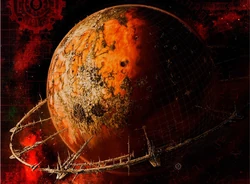
Mars, ancient homeworld of the Adeptus Mechanicus.
At their first sight of the Master of Mankind many Tech-priests were overcome with the feeling that they had met the living embodiment of the Omnissiah, the Machine God clad in human form. In return for peace between Terra and Mars, the recognition of the Tech-priests' right to practice their faith and their right to maintain control over both Mars and the other Forge Worlds they had settled, the Mechanicum agreed to build Imperial starships at Mars' Ring of Iron orbital fleet yards and provide all of the war materiel necessary for the Emperor's Great Crusade.
In addition, the Mechanicum agreed to be bound by the Emperor's commandment to never develop certain forbidden technologies such as artificial intelligence. Though the Mechanicum had no knowledge of it, it was artificial intelligence that had nearly destroyed humanity once before during the rebellion of the Men of Iron in the Dark Age of Technology and the Emperor was determined not to repeat history. With the signing of this agreement, known as the Treaty of Mars or the Treaty of Olympus Mons within the Mechanicum, the Cult Mechanicum became the Adeptus Mechanicus of the new-forged Imperium of Man, and the Imperial Aquila was refashioned to bear two heads, one for Terra and one for Mars.
Yet the terms of this agreement did not sit well with some within the hierarchy of the Mechanicum. A minority of Tech-adepts believed that the Emperor was not the Omnissiah, for the Machine God that the Mechanicus had always worshipped actually lay sleeping deep beneath the crust of Mars in the Noctis Labyrinthus. These Tech-priests particularly chafed at the end of Mars' political independence and the imposition of the Emperor's restrictions upon what technologies the Tech-priests of the Mechanicum could research and develop. As the Great Crusade progressed into the early 31st Millennium, these simmering discontents would ultimately cleave the Mechanicum just as it would the wider Imperium.
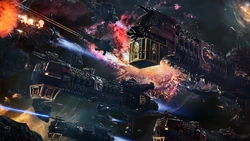
An Adeptus Mechanicus fleet, including an Ark Mechanicus, engages enemy vessels during the Quest for Knowledge.
During the Horus Heresy many Mechanicum units declared for the Warmaster Horus and fought against those of their faith who remained loyal to the Emperor, becoming known in later times as the Dark Mechanicus. These Traitor Mechanicum units initiated a civil war on the Red Planet known as the Schism of Mars that mirrored the larger conflict raging across the galaxy. The Fabricator-General himself sided with the Warmaster, but his deputy, the Fabricator Locum Kane, remained loyal to the Emperor.
Horus swayed the Fabricator-General of the time, Kelbor-Hal, to the side of Chaos by promising him a complete STC database from the planet of Drakonis-Three-Eleven and brought the senior Tech-adept in his 63rd Expeditionary Fleet named Regulus over to his side with other STCs recovered from the Imperial conquest of the Auretian Technocracy. Horus promised much else in terms of technological knowledge to the Mechanicum, including the right to develop technologies like artificial intelligence previously forbidden by the Emperor in the Treaty of Mars in return for their allegiance to his cause.
Many Master Adepts like Kelbor-Hal longed to pursue these restricted lines of research and had long believed that the Emperor was not the Omnissiah of the Machine God, for the true Machine God dwelled in the Noctis Labyrinthus deep below the crust of Mars. That this legendary creature may actually have been the C'tan shard known as the Void Dragon is a disturbing possibility.
The Quest for Knowledge
Over the long millennia since its inception, the Cult Mechanicus has been riven, reformed, brought to the brink of catastrophe, and has engaged in conquests that span the galaxy. Calculus Logi labour night and day to catalogue its history, though they disclose it not. Only a handful of events are allowed to reach the annals of Imperial truth:
M15-M25 The Age of Technology
Although existing accounts of the Age of Technology in the 41st Millennium are incomplete and unreliable, it is generally considered to be a golden era of technological development and interstellar expansion as Mankind first spreads across the galaxy.
The development of Warp-Drive, Navigators and Standard Template Construct (STC) database technology herald this new era of discovery. The first of what will later become known as Knight Worlds are established by Long March sublight cononisation vessels during this period. The Human mutants known as psykers first appear in ever-increasing numbers at the end of the period.
M25-M30 The Age of Strife
The collapse of Mankind's first interstellar civilisation comes with terrifying swiftness. It is difficult to unravel the truth, but tales abound of anarchy, Daemonic possessions, the coming of the Warp-entities known as the Enslavers and the betrayal of Humanity by its own thinking machines in the so-called "Cybernetic Revolt."
With the collapse of the Aeldari Empire and birth of the new Chaos God Slaanesh, the galaxy is engulfed by Warp storms that isolate vast swathes of settled space from FTL travel and communications. Those Human civilisations not destroyed outright are cut off from one another at the start of what Imperial historitors will later call the "Age of Strife."
Many people, particularly on Old Earth and Mars, come to know this era as "Old Night," and it descends like a shroud over the galaxy. During this time, the Human-settled Knight Worlds fare best among Mankind's colonies, for they eschew psykers and purposefully regress technologically. They grow superstitious and hidebound in their own traditions while they stand alone in a galaxy besieged by evils.
- Mars Expands and the Founding of the Mechanicum (M25-M30) - The beleaguered people of Mars overcome strife and disaster to reunite beneath the aegis of the newly-established theocracy of the Cult Mechanicus and the governing organisation of the Tech-priests known as the "Mechanicum." The Mechanicum Parliament is established, comprised of senior Tech-priests and magi, to govern the Red Planet. As lulls between the waves of Warp storms allow, the fleets of Mars travel outwards, raiding for lost technology and establishing new colonies of Tech-adepts dedicated to the worship of the Machine God that will grow into new Forge Worlds. With a few exceptions, such travels remain limited in scope and stay within the confines of what will later become known as the Segmentum Solar.
- Treaty of Mars (712.M30) - The Emperor, fresh from uniting the techno-barbarian tribes of Terra, arrives on Mars. Many of the Tech-priests declare him to be the Omnissiah, the avatar of the Machine God in the physical universe, and so the Emperor forges a successful political and military alliance with Mars. It is the adepts of the Cult Mechanicus that equip the Emperor's Space Marine Legions for the Great Crusade. In recognition of the fact that to achieve His galactic plans, the Emperor needs the technological and scientific aid of the Mechanicum, Mars becomes an ally to Terra rather than her subject, which is cemented by the signing of the Treaty of Olympus Mons, known as the Treaty of Mars on Terra, which also allows the Cult Mechanicus to maintain its religion in contravention of the newborn Imperium of Man's official atheistic doctrine of the Imperial Truth. Of the countless worlds that the Imperium soon claims, only Forge Worlds dedicated to the Cult Mechanicus are esteemed in such a way.
M30-M31 Dawn of the Imperium
- Great Crusade (798.M30-005.M31) - The Emperor leads the massive Great Crusade outwards from Terra, with the purpose of reuniting the hundreds of thousands of lost worlds scattered across the galaxy. At the fore are the Space Marine Legions, supported by the growing Imperial Army. All are equipped by the factories of Mars. No less important are the Skitarii Legions, the Legio Cybernetica, the Legio Titanicus, and the Imperial Knights that join the expedition. Planet after planet is reconquered and offered the same choice -- bow before the Emperor of Terra or be destroyed. On and on the Expeditionary Fleets push outwards. The Tech-priests often refer to this time as the Great Expansion, for hundreds of Knight Worlds are rediscovered during this period alone.
- Horus Heresy (005-014.M31) - Like all of the branches of the Imperium, the Mechanicum finds itself rife with corruption during the epic civil war known as the Horus Heresy. Many Forge Worlds and Knight Worlds turn from the Emperor. Indeed, the Fabricator-General of Mars, Kelbor-Hal himself, declares his allegiance to Horus, and so begins the Schism of Mars, a bitterly-fought campaign that mirrors those taking place across the galaxy. Skitarii Legions square off against each other while Titan duels Titan. Those of the Cult Mechanicus that turn to the Chaos Gods are forever after known as the Dark Mechanicum. They are hated and feared in equal measure, for they dare to fuse daemons with the Machine Spirits of their war engines, creating twisted things that mock the Machine God and His true laws of order and reason.
- Birth of the Adeptus Mechanicus (012.M31) - A long-running political deadlock in the Council of Terra back on the throneworld of the Imperium is finally broken, facilitating the formal establishment of the Imperial Adeptus Mechanicus. The Adeptus Mechanicus is recognised as officially separate and distinct from the corrupted Mechanicum of Mars. Fabricator-General Zagreus Kane is appointed its first High Lord of Terra to serve on the council. Final judgement is enacted upon the captive followers of the Traitor Fabricator-General Kelbor-Hal, who are executed in their thousands. Immediately after, the union of Loyalist Titan Orders, under the umbrella of the Adeptus Titanicus or Collegia Titanica, is formed by the Grand Masters of several major Loyalist Titan Legions, although the future of other loyal former Mechanicum divisions such as the Legio Cybernetica and the regular military forces of the Taghmata remains unclear.
- The Great Scouring (014-021.M31) - Wars of recrimination follow the Horus Heresy. Led by Roboute Guilliman and the Ultramarines, the Imperial forces fight battle after battle, driving the remaining Traitor armies back until they finally flee, seeking refuge in the Eye of Terror. The Knight Houses, their honour tarnished by the vile deeds of fallen Knights, are especially vehement in their pursuit of battles of vengeance. Recognising the need for systemic change, Guilliman creates the Codex Astartes, and tasks Archmagos Dominus Belisarius Cawl with a secret task that will align the fates of the newly-forged Adeptus Mechanicus and the Space Marines for centuries to come.
M31-M32 Age of Rebirth
The Mechanicum of old is reforged as the Adeptus Mechanicus following Lord Commander of the Imperium Roboute Guilliman's Reformation of the Emperor's realm and the new Fabricator-General of Mars is given a permanent position as a High Lord of Terra. Crippled by His wounds during the final Heresy battles, the Emperor is interred within the Golden Throne, a device so complex that only the Adeptus Mechanicus can hope to maintain its systems.
- The Shadow War (Unknown Date.M31-Present) - An intense paranoia drives the Cult Mechanicus to bury their secrets deep. When the Inquisitors of Terra's new order take their tithe of data-tapestries, they also unwittingly take the countermeasures that will unravel them. Aware of their mistake but unwilling to admit it, the Inquisition devises purge protocols that engage in an unseen battle with the self-replicating deletion-programs of the Cult Mechanicus. Though this shadow conflict flares up into several planet-wrecking wars before fading, battles between them still rage in secret to this day.
- The Giridium Experiment (011.M32) - The Cult Mechanicus builds a fortress around the "haunted" caves of Giridium. During the manifestation which occurs every equinox, the disciples of the Omnissiah blast apart rank upon rank of red-skinned daemons. The process is repeated for nine long standard years. Just as the Adeptus Mechanicus are compiling reports and preparing to withdraw, the sky above yawns wide and disgorges a rain of capering, whirling flame-daemons. The ensuing battle rages for solar months, and when a new wave of blood-horrors bursts from the caves at the next equinox, the combined daemonic onslaught sees the personnel of the Cult Mechanicus present slain to a man.
- A New Breed of Overseer (Unknown Date.M32) - House Taranis begins the practice of sending the Nobles that fail to enmesh properly with their Imperial Knights to the Adeptus Mechanicus. Though unfit for a place in Taranis' Knight armies, each of these cyborg warriors -- known as Psychosis-Neuracanium -- are from primaris-grade Imperial stock, and prove to be excellent raw material for the creation of Skitarii overseers. Similar exchanges between other Knight and Forge Worlds occur across the galaxy.
M33-M34 The Forging
As the Imperium solidifies its measures of control across key star systems, including the adoption of the Imperial Cult as the official state religion, the Adeptus Mechanicus becomes ever more secretive.
- The Howling (401.M34) - An Adeptus Mechanicus Explorator fleet clashes with the Cacodominus, an alien cyborg of colossal psychic potential. The horrific creature learns well of Humanity and its agents. Within a standard year it controls the populace of thirteen hundred planetary systems. The resultant heresy is ended by a concerted attack from the Legio Cybernetica and their Black Templar allies. Alas, the Cacodominus' psychic death scream burns out the minds of a billion Astropaths and distorts the signal of the Astronomican itself. Entire sub-sectors slide into barbarism without the light of the Emperor to guide them.
- The Prophet of Cogs (979.M34) - The long-time rivalry between those Tech-priests who dwell in the north of Mars and those of the Martian south flares up into open war. As the conflict grinds on, both sides are assailed by the feral packs of malfunctioning Servitors and burnt-out war machines that haunt the desert wastes. The war reaches a gory conclusion when the self-proclaimed "Prophet of Cogs" broadcasts a control-chorus that binds millions of long-abandoned machines to his cause. Appalled by the half-living cyberghouls he sets on his foes, both the Martian north and south unite to drive him from the face of the Red Planet. Rumours persist that he haunts the Alpha Centauri System well into the 41st Millennium.
M35-M36 Nova Terra Interregnum
The Time of the Two Emperors during the Nova Terra Interregnum pits many forces of the Imperium against each other, and all Forge Worlds are asked to declare their allegiance.
- The Moirae Schism (ca. Early M35) - During the secession of the Segmentum Pacificus during the Nova Terra Interregnum, the rebel Forge World Moirae is destroyed by retaliatory Exterminatus, but not before the Moirae Schism has split the Adeptus Mechanicus in two. The ensuing conflict draws Titan Legions and even those Space Marine Chapters affiliated with the Adeptus Mechanicus into the turmoil. The schism takes a heavy toll on the Adeptus Astartes, resulting in the destruction of dozens of companies and the excommunication of several Iron Hands clans. It takes over two millennia of desperate warfare before the Moirate doctrines are considered fully purged.
- The Fleet Wars (Unknown Date.M35) - Of all the battles of the Moirae Schism, none are so expansive or long-lasting as the prolonged naval engagement over the nebula space fields of the Gulf of Black Shadows. There, mining wars between rival Forge Worlds escalate to massive fleet battles. It is estimated that the wrecks of over ten thousand voidships -- from mining craft to vessels of war -- float between the gas clouds. Yet the battle is far from over, for within the floating graveyards, salvage crews continue the war for centuries, fighting each other in desperate boarding actions, each side seeking to reclaim valued technology. Entire robot maniples are recovered by opposing sides, and reprogrammed to attack their former controllers.
M36 The Age of Apostasy
A new age of dissent washes over the Imperium. A growing distrust separates the Adeptus Mechanicus from the Adeptus Ministorum, with each side conspiring against the other. Few records of their internecine battles are ever recorded by the Adeptus Administratum, but each side keeps their own secret tally.
- The War of Recovery (104.M36) - Twelve Knightly houses are led by the Adeptus Mechanicus into the Mortuam Chain system. The campaign lasts over a standard century and many human worlds are freed from xenos rule. The interfering Aeldari are defeated when their own weapons are turned against them. Much ancient technology is rediscovered by the great quest. The fact that one of the conquered worlds had already been converted into a Shrine World by missionaries from the Ecclesiarchy is hastily covered up by furtive Tech-priests, who speak only of the triumphant return to Mars of several first-generation STC databases.
- The Xenarite Schism (335.M36) - The Forge World of Stygies VIII comes under attack from dozens of Deathwatch Kill-teams when news of the Xenarites' dabblings with alien technology reaches the Ordo Xenos. The Adeptus Mechanicus are forced to employ radical measures in order to survive the ensuing purges.
M37-M40 The Age of Redemption
The Imperial Cult gains political momentum, and countless crusades are launched. As the Space Marines and Imperial Guard are drawn into more and more campaigns, the Adeptus Mechanicus conserve their strength, focusing on their own expeditionary fleets, as well as their manufacturing duties to supply the Imperial war machine.
- Missing from Imperial Records (Unknown Date.M37) - Fearful of the growing record of violations against its Tech-priests, the Forge World of Stygies VIII uses viral programming, machine canticles, and infiltration methods to destroy or alter the documentation of the Adeptus Administratum and even the datastacks of the Inquisition itself. Self-perpetuating programs ensure the obfuscation is continuous.
- The Occlusiad (550-560.M37) - The northwestern fringe of the galaxy is ravaged by the Apostles of the Blind King. Rogue Tech-priests who view Humanity as an affront to the Machine God, the Apostles uncover artefacts lost in the Dark Age of Technology that allow the creation of supernovae from the hearts of living suns. Constellations are forever changed as the Apostles purge the outer sectors of the Segmentum Obscurus. War rages for a solar decade as thousands of heretical macroclades and robotic Cohorts Cybernetica exterminate all human life from world after world with chilling efficiency. The tide turns only when Navigator Joyre Macran discovers the palace-warship of the Blind King hidden in a fold of Warpspace. Macran guides the Emperor-class Battleship Dominus Astra to the palace's location and the Blind King is slain. Without his prescience, the Apostles are overcome -- not least due to the efforts of Mars itself and the founding of the heroic Dark Hunters Chapter of Astartes.
- The Telok Expedition (383.M38) - The Radical Magos Vettius Telok leads a foray into the void beyond the Halo Stars in search of the fabled artefact known as the "Breath of the Gods." His expedition is reported lost with all knowledge.
- The Shadow of Silica Animus (Unknown Date.M38) - Proof is found of dangerous experiments being conducted by rogue cults within the Mechanicus. As the creation of complex and intelligent artificial minds is strictly outlawed, a search-and-destroy inquest begins that probes every single Forge World for signs of the forbidden technology.
- War of the Golden Cog (Unknown Date.M39) - The Fabricator-General of Mars claims ownership of the riches of the Fortress of the Soulless, lair of the Culexus Temple. A disastrous civil war between Mars and Terra is averted by a sniper's bullet, but the artefact known as the Golden Cog is left in Skitarii hands.
- Fires of Conscience (Unknown Date.M39) - The rogue Tech-priest Veriliad, after leading his Skitarii to a stomach-churning victory during the Cremation of Alcadia Secundus, knowingly destroys the STC for Phosphex Weapons.
M40 The Waning
With Imperial armies stretched thin across countless campaigns, the Imperium becomes ripe for invasion. Xenos and Chaos attacks increase tenfold, occurring with alarming frequency all across the galaxy.
- Crushing the Mecha-WAAAGH! (Unknown Date.M40) - Led by House Raven, five different Knightly houses, along with no less than a dozen Freeblades, halt the mechanised hordes of WAAAGH! Gluttok. Across several star systems, the Imperial Knights are able to counter the Battlewagons and looted tanks employed by the wily Gluttok. It is on the factory planet of Blastoom that the Warboss' Stompa Mob is at last brought to final battle. Leading his Exalted Court into the thick of the fighting, Grevan, the Iron Duke, smashes into the wall of Ork walkers and uses his Reaper Chainsword to rip apart Gluttok's Stompa. The Stompa's head can still be seen, for it was taken for display and remains at the Keep Inviolate.
- Graia Assailed (Unknown Date.M40) - When attempting Warp travel with its "Graian Crown," Forge World Graia is assaulted by Necrons and nearly destroyed.
- The Forbidden Runes (Unknown Date.M40) - After the disastrous Battle of Elixia, Skitarii survivors are sent to extract the runic inscriptions upon the ancient standing stones of Grave's End. In doing so, they open a long-forgotten gate into the Warp. Elixia is consumed by a daemonic invasion, its remaining populace eliminated by a necessary Exterminatus within the solar week.
- The Reality Cage (743.M40) - The Tech-priests of Venatoria create cagefields of pure law and reason that magnify the material dimension's inherent resistance to the energies of the Warp. Forbidden to test the resultant technology in realspace, the Tech-priests lead an invasion fleet into the Ocularis Terribilis -- the Eye of Terror. Three Venatorians make it back alive to their Forge World. They devote the rest of their careers to the creation of a "reality bomb" that they believe will seal the Eye of Terror forever more. Sadly, their test run, staged upon the yawning Warp rift known only as the Maelstrom, ends in disaster.
M41-M42 The Time of Ending and Era Indomitus
As the galaxy darkens, new threats arise all across it.
- The Exhubris Portal (029.M41) - The rune-sealed portals upon the world of Exhubris II's grand archipelago are hidden within a landscape of leech-infested pyramids, but the Stygian Cult Mechanicus makes it their mission to open them. The excavation is well under way when a large force of Eldar from Craftworld Ulthwé arrive without warning to assail the Cult Mechanicus work teams. Stygies VIII requests aid from a nearby Martian fleet. So determined is their defence that the reinforcements have time to make planetfall in great number, and the Eldar ground forces are hammered to ruin. The runic portal is broken open, and Tech-priests from both Stygies and Mars enter the lambent labyrinth beyond.
- Gothic War (139-160.M41) - The Gothic War, also called the 12th Black Crusade, was a vast military campaign against the Imperium of Man launched by the Warmaster of Chaos Abaddon the Despoiler of the Black Legion in 139.M41 which lasted until 160.M41. The conflict consisted of hundreds of planetary invasions and naval battles within the Gothic Sector and only ended when Abaddon was forced to retreat to the Immaterium with the arrival of Imperial reinforcements. It saw the destruction of several planets and four of the six known Blackstone Fortresses, as well as the deaths of billions of Imperial citizens.
- The Baited Beast (173.M41) - The Cult Mechanicus deliberately triggers WAAAGH! Kragga in the tightly-held Urdeshi System. Though the WAAAGH! boils out of control planetside, the Imperial Navy keeps it contained to Urdesh and its neighbouring worlds. The Tech-priests greedily harness every screed of information; so much data is gathered their overheating archives have to be relocated to the cool of Urdesh’s underground catacombs. Eventually the greenskins are methodically exterminated clan by clan. The next three centuries are spent cleansing and rebuilding the Urdeshi System. In the process, the invaluable data-catacombs are filled with rockcrete to form foundations for a grenade manufactorum.
- The Macharian Conquests (392-399.M41) - Led by Mars, Graia and Gryphonne IV, many Forge Worlds send armies to aid the massive crusade of Lord Commander Solar Macharius, the Imperium's greatest Astra Militarum commander of all time and a recognised tactical and strategic genius on a par with the primarchs themselves. This Imperial Crusade took place on the far western edge of the galaxy within the Segmentum Pacificus, reaching as far as the border of the galaxy with intergalactic space and even reaching into the unknown regions of the Halo Zone. The furthest extent of this crusade reached just beyond the edge of the Segmentum Pacificus, where not even the blessed light of the Astronomican could penetrate the dark void.
- The Death of Tyran (745.M41) - A terrible new foe looms from the void. On the far reaches of the Eastern Fringe, the Adeptus Mechanicus research station of Tyran Primus comes under attack. Despite a stalwart defence by Skitarii cohorts and an entire regiment of Astra Militarum, the planet is conquered and its biomass devoured. Magos Varnak compiles a data-codex that reveals the dread truth of the planet's last few solar hours and fires it into space before triggering the outpost's runes of ending. The Tyranids enter the galaxy.
- Rain of Fire (Unknown Date.M41) - After the Battle of Macragge, a splinter fleet of Hive Fleet Behemoth winds its way into the Skitarii-held Daugel Helix. Using the knowledge recovered from the Tyran data-codex, the Skitarii fight back. The cohort commander Alpha 9-Thyrrc tuns the tide by saturating a stratum of the atmosphere with gas from the planet's Promethium refineries. After his Onager Dunecrawlers' neutron lasers set the skies aflame, each new rain of Tyranid Mycetic Spores incinerates those xenos planetside instead of reinforcing them. A triumphalist data-codex is compiled and sent to the nearby Forge World of Accatran, where it is swiftly filed away in the Archive Anomalis and forgotten.
- The War of Neotech (Unknown Date.M41) - The T'au settlers of Vesh'yo find themselves fighting for their lives against three Skitarii Legions. The ancient weapons of the Adeptus Mechanicus are pitted against he clean, cutting-edge technology of the T'au Empire. Many additional Skitarii reinforcements are deployed before victory is finally secured. Six star freighters full of T'au war materiel find their way back to the Forge World of Tigrus.
- WAAAGH! Grax (Unknown Date.M41) - The brutal juggernaut of WAAAGH! Grax terrorises the star systems near Ryza. Legions of Skitarii counterattack alongside Catachans and liberated human slaves. Word of the intense fighting attracts WAAAGH! Rarguts, which breaks through the Imperial Navy cordon to invade Ryza for the third time since the conflict began. The fate of a string of Imperial star systems hinges upon the Forge World at their heart.
- The Curse Entropic (865.M41) - A Chaos Warfleet of Iron Warriors and Daemon Engines unleashes a destructive machine curse upon Cypra Mundi. Soon the Forge World runs with rivers of molten metal, its surface dotted with a million burnt-out machines. Just as all seems lost, the Cult Mechanicus coordinate a psalmic banishment that lifts the curse, leaving the Chaos Space Marines bereft of their daemon allies. The planet is cleansed within a solar week.
- The Caverns of Calth (979.M41) - Rumours circulate of a unique Tyranid bioform unearthed from the ice of Calth's polar crust. Magos Locard leads an Explorator army into the Realm of Ultramar, delving deep under the planet's cold skin within solar minutes of planetfall. The Torsion Cannons of hundreds of Battle Servitors grind a path towards unsanctioned life signs in Calth's ancient tunnel networks. They do not find the legendary Carnifex they were expecting, but nest upon nest of burrowing, serpentine horrors. A desperate subterranean battle breaks out in the darkness, and Magos Locard is forced to leave empty-handed.
- To Punish the Usurper (983.M41) - Upon the lodestone world of Knuthor, a nation of feral humans worships their Ork slavers as prophets of the primitive deity King Thug. When the nearby Forge World of Graia learns one of the Ork Roks is built around a fabled Ark Mechanicus, it sends forth its legions on a priority intercept. Within a standard year of the travesty coming to light, both xenos and human alike have been scoured from the planet, and the salvaged pieces of the Ark Mechanicus borne reverently back to Graia.
- The Unknowable (Unknown Date.M41) - Skitarii from Stygies VIII are sent to the diluvian-class world of Magogue when the planet's industry dries up its oceans to reveal Necrontyr architecture. The Skitarii fight valiantly against the Necrons of the awakening tomb complexes, allowing the planet's islander people to evacuate. Only the commanding Tech-priests, hunting for knowledge behind the lines, escape the ensuing carnage. However, in doing so they clash with Trazyn the Infinite. One by one the Tech-priests are collected in stasis fields and displayed as part of a monument to Magogue's fall.
- The Omnitask Blashemy (988.M41)
- Scouring of Johan's Eden (992.M41) - An ancient data-cache is unearthed upon the Jungle World of Johan's Eden. The Cult Mechanicus descends, only to find the planet's modest populace slain by Necron Canoptek constructs. Several Mechanicus war congregations launch a simultaneous attack. Eight standard years of war follow before the Cult Mechanicus recovers the data-cache. Three intact STC database files are recovered as a result -- one for self-heating cookpots, one for parchment autoquills, and one for stable flux-core bolt rounds that can melt ceramite as if it were wax.
- Tyrannic Wars (992.M41 and 997-999.M41) - The Tyranid invasion wreaks havoc across scores of Forge Worlds, with several, including the powerhouse of Gryphonne IV, utterly destroyed by the ravenous xenos.
- Return to Abheilüng (674.999.M41)
- Ultimate Power (ca. 900s.M41) - Clues to the location of the Omnicopaeia are uncovered upon Hell's Teeth, a Daemon World on the edge of the Maelstrom. The Omnicopaeia, an arcane device that contains every STC with a psychic component, is of immeasurable value. Many billions of Skitarii are dispatched to Hell's Teeth with all haste. The entire Adeptus Mechanicus across every Forge World takes notice -- should the legendary Omnicopaeia be found, they will finally have a way to control, precipitate and even weaponise Humanity's psychic dawn.
- Desperate Measures (986.999.M41) - The Tech-priest custodians at work in the Imperial Palace uncover irrevocable failures in the mechanisms of the Golden Throne. A dozen contingency expeditions are immediately launched, including a Xanthite war procession of the Inquisition sent through the Exhubris Portal into the Webway. The Xanthites fight through Harlequin troupes and daemon hordes alike before reaching their intended destination. In the grave-cold oubliettes of the Haemonculi beneath the Dark Eldar city of Commorragh, a sinister bargain is struck...
- Fall of Cadia (995.999.M41) - The 13th Black Crusade devastates much of the Cadian Sector and spreads disaster across the whole of Segmentum Obscurus. Despite heroic fighting, Cadia falls. Many refugees from the numerous campaigns find temporary safety on the Forge Worlds of Agripinaa and Stygies VIII, where their numbers help repel the Chaos attacks that soon follow. The loss of dozens of Titans, fleets, robots, and entire armies is a devastating and irreplaceable blow. In the wake of the disaster, the High Lords of Terra themselves decree that all Forge Worlds are to increase production by any means necessary.
- A Primarch Awakens (ca. 999.M41) - In news that ripples across a galaxy riven by war and splintering with Warp disasters, the Ultramarines Primarch Roboute Guilliman is awakened. Although xenos are rumoured to be involved, the Adeptus Mechanicus claim sole responsibility for the deed that brings back the Avenging Son.
- Great Rift Opens (ca. 999.M41) - Warp Storms of a magnitude not seen since the Age of Strife wrack the galaxy. Every Forge World is cut off from its Explorator fleets and, for a time, from each other. All suffer invasions and raids as emboldened xenos and Chaos forces test them, probing for weaknesses, eager to destroy the bastions of Mankind's empire. No fewer than seven Forge Worlds are destroyed altogether and several more remain missing, buried beneath fierce and impenetrable storms.
- The Secrets of Cawl (ca. 999.M41) - Upon the orders of Primarch Roboute Guilliman, now the lord commander of the Imperium and the Imperial Regent, Archmagos Dominus Belisarius Cawl begins to unlock the secret vaults and awaken from stasis the many armies of the Primaris Project. An entire new Founding of Space Marines is born.
- Storm of Metal (ca. 999.M41) - All across the Imperium after the birth of the Great Rift, primary Mechanicus holdings -- from mining colonies to Knight Worlds to Forge Worlds -- found themselves under attack from Necrons. The massive influx of Chaos energies had triggered anti-Warp protocols in every Necron Tomb World, and things that had lain dormant for aeons stir once more. The infamous Technomandrites of Magistrakh, struck down by the ruling Necrontyr Silent King eons before, returned. Panic rose amongst the Tech-priests, for they were already besieged from without, and the Necron threat was coming from within.
- The Indomitus Crusade (ca. 999.M41-111.M42) - The initial blackness that blanketed the galaxy after the Great Rift was torn open finally lifts. In the aftermath of the Noctis Aeterna, many Imperial Crusades are launched. Although there were several successful campaigns, none could claim more triumphs than the Indomitus Crusade. From Terra, Roboute Guilliman mustered a coalition. In addition to Archmagos Belisarius Cawl, Mars sent many Skitarii Legions, maniples of the Legio Cybernetica and several lances of Knights from House Taranis. Over a dozen other Forge Worlds send supporting fleets as the expedition crosses the galaxy, and many Knight Worlds prove eager to join -- none more so than the vengeful House Krast. The Crusade's many victories bring a glimmer of hope to the darkened Imperium. However, once Guilliman leaves, returning to aid Ultramar during the Plague Wars, the remaining forces splinter, the campaign losing impetus as factions return to protect their own homeworlds.
- Duels Without Honour (Unknown Date.M42) - The fallen Knights of House Black, not seen since they escaped into the Eye of Terror during the Great Crusade, return. The fell Knights are seen across hundreds of battlefields, appearing as if from nowhere to ambush the forces of the Imperial Knights.
- War of Slime and Metal (Unknown Date.M42) - Metalica is besieged by the Plaguehosts of Nurgle, the 3rd and 7th Plague Companies of the Death Guard, Renegade Chaos Space Marines, the corrupted Titans of Legio Morbus, and no fewer than seven fallen Knight houses. Only the arrival of the entire House Raven staves off defeat, and only with the aid of a war fleet from Deimos is the attack finally broken and the daemons banished.
- The Adeptus Mechanicus Unleashed (Unknown Date.M42) - With the Imperium reeling from the disastrous effects of the Great Rift, Mars commands all Forge Worlds to ramp up production to unprecedented levels. They churn through raw materials and servitors as never before, and vast armadas are launched to strip entire star systems of resources. The forges must be fed at impossible rates in order to supply the endless war materiel required.
- Rust Fields War Begins (Unknown Date.M42) - To fuel their factories, a coalition of Forge Worlds led by Mars and Graia sends mining fleets to exploit the vast belt of asteroids known as the Rust Fields.
Although its interior has never been explored, its exterior is incredibly rich in all manner of metals, minerals and promethium seas -- a tumbling horizon of asteroids that stretches across three sectors. Soon after operations are begun, however, it is discovered that Greenskin tribes rule the interior of the Rust Fields. So begins a great war that draws in untold numbers of additional Imperial forces as the Adeptus Mechanicus fights to retain its foothold.
- Bane of the Forge Worlds (Unknown Date.M42) - Although there are many theories, none understands the reason for the Necron attacks upon Forge World territories as well as Archmagos Belisarius Cawl. Both sides are seeking deposits of the strange material -- blackstone -- from which the Cadian Pylons were fashioned, and many Adeptus Mechanicus strongholds have been erected upon sites containing this precious resource. Cawl sends his own agents -- armies of Mars and House Taranis -- across the stars in an effort to combat the growing danger, and hundreds of battles are fought as more and more Forge Worlds are drawn into the conflict to aid their beleaguered brethren. Even those Tech-priests that begin to understand the reality of the dire situation are loath to call upon their Imperial allies for fear of being branded Hereteks.
- Plague Wars (ca. 111.M42) - At the urgent call of Roboute Guilliman, over a dozen Forge Worlds, including Mars, Ryza, Metalica, and Triplex Phall, send reinforcements to Ultramar. There they aid the Avenging Son's armies in defence and counterattack against Chaos Renegades and the Death Guard.
Pre-Heresy Mechanicum Forge World Hierarchy
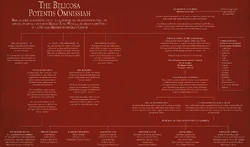
The Belicosa Potentis Omnissiah, an Exemplary Illustration of the Military-Feudal Organisational Structure of a trans-Martian Forge World during the Great Crusade
The following is an exemplary illustration of the military-feudal organisational structure depicted in the abstract of a trans-Martian Forge World, as rendered by the Office of the Principia Militaris of the Great Crusade early in the first decade of the 31st Millennium.
- Archmagos Intendant (Planetary Governor) - An Archmagos Intendant was given equal rank to an Imperial Commander and Planetary Governor, with full executive, temporal and spiritual power over their domains, with notional fealty only to Mars and the Emperor. Note that various alternative nomenclatures for this title are used on different Forge Worlds (e.g., Hierophant Technis (Ryza), Gnostarch (Antioch Majoris), Fabricator Potentate (Tigrus), Vox-Omnis (Incaladion), Revered-Comptroller (Phaeton Prime).
- The Holy Synod of the Lord Magos (Ruling Feudal-Clerical Oligarchy of the Forge World) - Each member of the synod is a magnate and sub-ruler of their own domain or forge-fane, as well as a high-ranking priest of the Cult Mechanicus, tied to the larger web of the Forge World through a complex network of alliances, preference, arcane technological specialty and religious rank.
- Notional Synod seniority by title in order of power:
- The Archmandriture (Chamber Cardinal)
- The Archmagos
- The Magos Majoris
- The Magos Ordinary
- Notable Divisions of Techno-Arcana among the Synod commonly included:
- Hespherstari
- Provender
- Explorator
- Genetor
- Logis
- Vulpaxis
- Metallurgicus
- Lictanex
- Dominus
- Cordantor
- Mhalagra
- Alchemys
- Myrmidex
- Lachrimallus
- The Taghmata Omnissiah - The Taghmata Omnissiah was a military command protocol enacted in times of war or to create a detached military formation varying in size from sub-division to macro battle group, constructed by predetermined configurations of retainer troops, Tech-priests, war engines and support systems, placed under the command of a number of Magi of the Synod and commanded by Magi/Archmagi designated "Prime".
- The Legio Cybernetica - Sacred orders of Tech-priests devolved into cohorts charged with the construction and use of Battle-automata, existing both as fully independent structures and sub-factions owing either pacts of mutual support or alliance with the Synods of major Forge Worlds.
- The Magos Militant/Secutarius - Lower ranked Magi as well as assigned Tech-priests and prelates of militant sub-cults of the Mechanicum utilised by the Taghmata as a field command and control cadre. Each will commonly possess their own acolytes, retainer forces and sub-units owing them direct fealty.
- Principal Tactical Divisions of the Taghmata
- Associated Orders & Sub-Cults Militant - Composition will vary greatly depending on the Taghmata disposition, role and the tendencies and alliances of the governing Forge World Myrmidon Cult, etc:
- Lacyraemara
- Indentured Labour Units
- Adseculatis Modified Troops
- Bio-Alchem Cadres
- Tech-priest Lacyraemarta Covenants
- Cyber-Hybrid Carnivora
- Munitoria Logis - Provender of Munitions and Wargear, Servitor and Drone Cohorts. Assigned to Taghmata service.
- Signatus Avox
- Lexmachanicus Auditorii
- Macrotechnia
- Enginseer Covenants
- Tech-thrall Combat Units
- Macro-Machina
- Ordinatus Locum
- Technographica Determinus
- Bonded Cybernetica
- Battle-Automata
- Siege-Automata
- Bonded Tech-priest Covenants
- The Autokrator
- Ground Armour
- Pioneer Forces
- Mobile Artillery Units
- Tech-Guard Regiments
- The Knight Houses of the Questoris Familia - The ruling noble houses of the Knight Worlds form their own unique culture and traditions from their own unique culture and traditions which have become closely linked with the Mechanicum over time. Households often deploy alongside the Legio Titanicus in support.
- Principal Tactical Divisions of the Taghmata
- The Basilikon Astra - The division of the Machine God's servants tasked with the construction, use and operation of void craft and interstellar vessels. This order's divisions by their nature control the outer reaches of a Forge World's systems and so stand apart from the planetary synods, but are still tied to them by dependence and ancient tradition.
- The Skitarius (Tech-Guard) - Ancient standing armies of elite cybernetically and genetically engineered troops, originating on Mars and principally loyal to the office of the Fabricator-General. The Skitarii, also known as the Mechanicum Protectors, are not members of the priesthood, but follow their own unique martial traditions and sub-cult of the Omnissiah. Skitarii regiments maintain entirely separate structures of organisation and tactical deployment outside of the Taghmata and are assigned at the behest of the Lords of Mars.
- The Prefecture Magisterium - Doctrinal covenant of the Machine Cult charged with preserving dogma and the persecution of techno-heresy. Magisterium Cohorts and hunter-killer claves are maintained on all Forge Worlds under the authority of the Archmagos Intendant.
- The Legio Titanicus - The division of the Titan Legions, the Princeps and Moderatii of the Legio Titanicus are charged with the baleful right and onerous duty of mastering and maintaining the God-Machines that are the avatars of the Omnissiah's destructive wrath. The manifold Titan Legions are spread through the Omnissiah's domains as their shield and their strength, as well as operating as the hammer of the Great Crusade. The Legio Titanicus form an ancient military society existing in parallel with the Mechanicum priesthood, including their own support structure, domains and military retainers (Scutarii).
- The Ordo Reductor - Mendicant order of Tech-priests devoted to the art of siege craft, demolition and mass destruction. The Ordo Reductor is essentially nomadic, gravitating to areas of intense warfare, but maintains links to major Forge Worlds for resupply and support.
Post-Heresy Adeptus Mechanicus Forge World Hierarchy
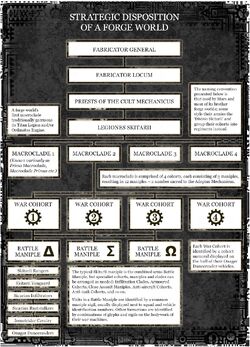
Imperial chart depicting the Strategic Disposition of a standard Forge World in the late 41st Millennium
- Fabricator General
- Fabricator Locum
- Priests of the Cult Mechanicus
- Legiones Skitarii - The naming convention presented below is that used by Mars and most of its brother forge worlds; some style their armies the "Divsion Skitarii" and group their cohorts into regiments instead.
- Macroclade 1 - (Known variously as Prima Macroclade, Macroclade Primus, ect.) A forge world's first macroclade traditionally garrisons its Titan Legions and/or Ordinatus Engines.
- Macroclade 2
- Macroclade 3
- Macroclade 4
- War Cohort 1 - Each War Cohort is identified by a cohort numeral displayed on the hull of their Onager Dunecrawler vehicles.
- War Cohort 2
- War Cohort 3
- War Cohort 4
- Battle Maniple Delta - The typical Skitarii maniple is the combined arms Battle Maniple, but specialist cohorts, maniples and clades can be arranged as needed: Infiltration Clades, Armoured Cohorts, Assault Maniples, Anti-aircraft Cohorts, Anti-tank Cohorts, and son on. Units in a Battle Maniple are identified by a common maniple sigil, usually displayed next to squad and vehicles identification numbers. Other formations are identified by combinations of glyphs and sigils on the bodywork of their war machines.
- Battle Maniple Epsilon
- Battle Maniple Omega
- Priests of the Cult Mechanicus
- Fabricator Locum
The Cult Mechanicus
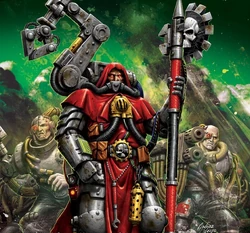
Cult Mechanicus Adept with Combat Servitors
The Cult Mechanicus believes knowledge to be the manifestation of divinity, and holds that anything embodying or containing knowledge is holy because of it. The supreme object of devotion is therefore the omniscient Machine God (also known as the Deus Mechanicus or, in its embodied form as the God-Emperor, the Omnissiah), an eminent and omnipotent spirit governing all machinery and knowledge in the universe. Generally, this deity is held to be an aspect of the God-Emperor (or, most commonly within the Cult itself, both are held to be aspects or faces of the same divine being). The Omnissiah is believed to be friendly to humanity, and to be the originator of all human technological and scientific knowledge. Subservient to the Omnissiah are the pantheistic Machine Spirits, who are believed to inhabit all machinery and which must be appeased before a piece of technology is used or repaired, lest the machinery fail.
It should be noted that the Void Dragon, one of the C'tan Star Gods who are the true masters of the Necrons, is supposedly hidden somewhere beneath the surface of Mars. This could be what the Adeptus Mechanicus actually worship as the Machine God. The existence of the C'tan beneath Mars is a highly classified secret of the Imperium.
The Quest for Knowledge
"The universe is not like a puzzle-box that you can take apart and put back together again and so solve its secrets. It is a shifting, uncertain thing which changes as you consider it, which is changed by the very act of observation. A powerful man is not a man who dissects the universe like a puzzle box, examining it piece by piece and measuring each piece with scientific precision. A powerful man has only to look upon the universe to change it."
- — Techno-Magos Gaelos
The ultimate goal of the Cult Mechanicus is to understand and fully comprehend the glory of the Omnissiah. The communal and personal attempt at this form of enlightenment is known as the Quest for Knowledge. The Cult believes that all knowledge already exists in the universe, and it is primarily a matter of time before it can be gathered together to complete the Quest.
The Cult is therefore disinclined to perform most basic scientific research and development. Despite this, some original scientific research does continue on Mars and the other Forge Worlds of the Imperium, enough to keep Imperial technology advancing steadily, if extremely slowly. The faith of the Cult is defined by a series of sixteen precepts, known as the Sixteen Universal Laws, which have been divided into two sets of eight precepts known collectively as the Mysteries and the Warnings, which are listed below.
The Mysteries of the Cult Mechanicus
- Life is directed motion.
- The spirit is the spark of life.
- Sentience is the ability to learn the value of knowledge.
- Intellect is the understanding of knowledge.
- Sentience is the basest form of Intellect.
- Understanding is the True Path to Comprehension.
- Comprehension is the key to all things.
- The Omnissiah knows all, comprehends all.
The Warnings of the Cult Mechanicus
- The alien mechanism is a perversion of the True Path.
- The soul is the conscience of sentience.
- A soul can be bestowed only by the Omnissiah.
- The Soulless sentience (i.e. Necrons) is the enemy of all.
- The knowledge of the ancients stands beyond question.
- The Machine Spirit guards the knowledge of the Ancients.
- Flesh is fallible, but ritual honours the Machine Spirit.
- To break with ritual is to break with faith.
The Adeptus Mechanicus At Present
Despite the never-ending thirst for knowledge of all branches of the order, most Tech-priests of the Adeptus Mechanicus have lost the ability to innovate. No longer the master of its creations, the Cult Mechanicus is enslaved to the past.
It maintains the glories of yesteryear with rite, dogma and edict instead of true discernment and comprehension. Even the theoretically simple process of activating an engine is preceded by the application of ritual oils, the burning of sacred resins and the chanting of long and complex hymns.
Should mechanisms break down, as they often do in service to the Adeptus Mechanicus' war effort, a replacement must be found, or knowledge of how to repair the existing one must be learned. Across the galaxy, thousands upon thousands of Mechanicus armies and fleets are already searching, guided by a database begun before the birth of the Imperium. Once found, such items and knowledge are confiscated at all costs in the name of the Adeptus Mechanicus.
Factions
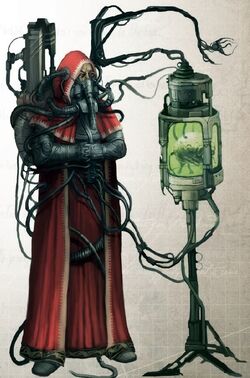
An Organicist Genetor
There are numerous religious factions within the Adeptus Mechanicus, including the Khamrians, who pursue the forbidden science of artificial, or "abominable" intelligence which has been forbidden since the catastrophe caused by the Iron Men who attacked humanity during the Dark Age of Technology; the Omnissiads, who seek to summon the Machine God into a physical avatar other than the Emperor; and the Organicists, who see biological enhancement using genetic engineering as equal to the more common cybernetic enhancements for which the Tech-priests of the Mechanicus are best known. Some of these sects are accepted as legitimate interpretations of the Omnissiah's will, others are persecuted by the broader Cult Mechanicus and the Inquisition as Heretics.
The portion of the ancient Mechanicum that split off to serve Chaos and the Heretic Astartes Traitor Legions during the Horus Heresy is called the Dark Mechanicum. These Chaos-worshiping Magi seek to combine the power of the Warp with that of the Machine God in the name of the Ruinous Powers, who they view to be the true expression of the Machine God since they offer knowledge that the Emperor forbids and place no restriction on the pursuit of any line of inquiry.
The Dark Mechanicum is also responsible for constructing the majority of the war-machines for the Chaos Space Marines. Such creations include the Stalk Tanks of the Blood Pact, the Hell Talon fighter-bombers and the gargantuan Harbinger bomber recently deployed by the Forces of Chaos. It is also believed that some Dark Mechanicum Adepts have split into the Chaos faction known as the Obliterators.
Tech-priests
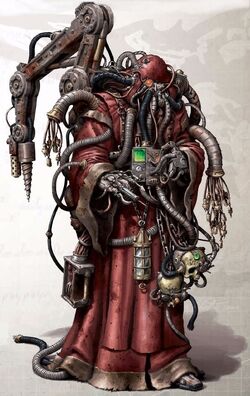
A Tech-priest of the Adeptus Mechanicus
Any member of the Cult Mechanicus over the rank of Menial will often be referred to generally as a "Tech-priest," though Magi and higher ranks are usually referred to by their rank. Tech-priests can usually be recognised by their clothing, which unless their work requires otherwise will be robes of rust-red or black colouration, and by their cybernetic nature.
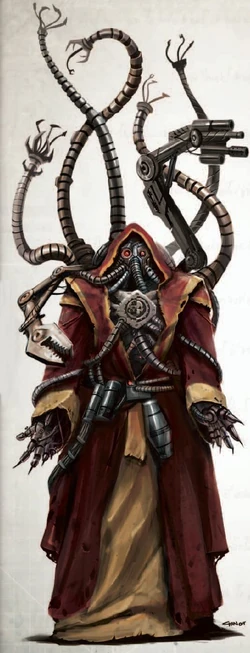
An Adeptus Mechanicus Logis with extensive Bionic modifications and Mechadendrites
Some Tech-priests also carry a large wrench-like tool, that doubles as an ax-headed close-combat weapon, adorned with Adeptus Mechanicus imagery upon the head. The amount of cybernetic augmentation found in a Tech-priest is highly dependent on his or her rank within the Cult Mechanicus.
A novice may have only one or two augmetic systems, if any, while very senior members may have only a few biological organs left in their bodies. Common cybernetic augmentations for Tech-priests include:
- Bionic limbs and organs, which may replace the originals because of an accident or simply because they provide enhanced capabilities or cater to the special needs the Tech-priest may face in their chosen work or scientific research.
- Bionic eyes, which allow a Tech-priest to see beyond the normal spectrum of human vision, augment or alter electromagnetic input to allow night vision or heat vision, and zoom in to magnify an image.
- Mechadendrites, bionic tentacles that attach to the spine to afford the Tech-priest greater mobility, greater lifting and manipulation capabilities, an easy neural interface with most other forms of technology and, in many cases, a handy weapon in a fight. These powerful devices are usually customised to suit the work needs of their wearer and can therefore include special features like medical equipment, maintenance tools or weapons. Larger Mechadendrites can often extrude a monomolecular blade or fire projectiles in combat or simply be used as a blunt instrument. A Cortical Implant is also usually required for the Tech-priest to be able to effectively control the additional limbs.
- Autosanguination, a process by which all the natural blood in a human body is removed and replaced with a more efficient oxygen and waste-carrying synthetic chemical substitute, allowing for the easier healing of wounds and more effective immunological defence against disease and toxins.
- Cortex Implants, which vary in function from simple memory circuit implants in the neurocortex intended to improve memory function to slim micro-cogitators that provide full computing abilities. Many senior Tech-priests use smaller implants of this type to preserve their mind and memories from the ravishes of time, and to lessen their dependence on fragile flesh. Cortex Implants of good quality are very rare and hard to produce, but provide the wearer eidetic memory and heighten their intelligence and ability to consume and correlate large amounts of data. Among the oldest Tech-priests only a few portions of the original brain tissue remain. The use of Cortex Implants is probably the primary reason why senior Tech-priests live far longer than the rest of the Imperial elite.
- Electoos, metal circuits embedded in the epidermic skin of Tech-priests to allow them to consciously channel the bioelectricity generated by their own bodies. These can be used in combat, or to revive a recalcitrant Machine Spirit. Those who specialise in the use of these and become essentially a living electricity generator are known as Electro-priests or "Luminen".
- Electro-grafts, which are similar to Electoos in that they are electric circuits embedded in the epidermic layer of the skin, but are distinct in their purpose. Electro-grafts serve as an interface for the Tech-priest with electronic machinery, particularly sources of digital data like Cogitators (computers). Given the right data-sources, a Tech-priest with electro-grafts can acquire many skills and much specialist knowledge instantly. One example of this are the pilots from the planet Glavia who have electro-grafts in the skin of their hands to enable them to interface with their starships with much greater efficiency.
- Vox-casters and voice-synthesizers, which often replace the normal speech organs of more senior Tech-priests. The quality of the synthesized voice is highly variable, from stilted and unnatural mechanical voices only as good as or worse than twenty-first century voice synthesizer standards to voices that sound almost entirely natural. The Tech-priests themselves generally do not seem to care what they sound like as long as they are understood. The main benefit of a Vox-caster appears to be that it allows the priest to communicate in what is termed "Binary". Essentially, Binary consists of bursts of coded noise with a twittering quality that can be used as an extremely effective cant known only to other members of the Adeptus Mechanicus (even the Inquisition cannot translate it) or it can be used as a means of datafile transfer.
More uncommon but still occasionally seen Mechanicus cybernetic augmentations include the:
- Mind Impulse Unit (MIU) - The MIU is a direct neural link between a human brain and a larger piece of external machinery allowing control by thought alone as if the machinery was a part of the human's body. These are most commonly found in massive pieces of technology such as Titans, Knights and starships, and very rarely in a normal Tech-priest. Some rare Tech-priests may use an MIU to control a shoulder-mounted weapon or similar device.
- Binary Cortex - The Binary Cortex is created during an operation in which the brains of two Tech-priests are joined in one body. Usually used only when two Tech-priests study the same subject and otherwise align very well in their thinking.
- Rite of Pure Thought - The Rite of Pure Thought is an operation which replaces the human brain's creative, emotional right half with a digital Cogitator (computer). This frees the Tech-priest of any remaining human emotion, basically turning him into a work-obsessed sociopath. However, this procedure is considered somewhat extreme even among the usually unsentimental Tech-priests.
Electoos
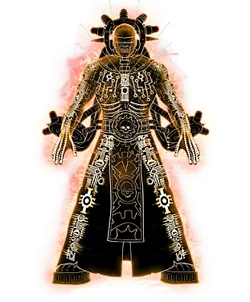
A schematic of the cybernetic grafts and electoos implanted within the body of an Electro-priest that allow him to unleash and absorb the Divine Current
Every one of the Omnissiah's worshippers is fitted with a personal electoo. Taking the form of subcutaneous circuitry, some of these devices are little more than small identifier-plates and information wafers that can only be accessed when illuminated by senior Tech-priests. Others are far more advanced. The electoo networks the brotherhoods of the Electro-priests implant beneath their skin are so extensive they cover the entire nervous system, their bio-electric pulses potent enough to send out bursts of scorching power known as a "voltagheist" field that intercept incoming projectiles. Through devices such as these, the manna of the Machine God can visit Fabricator-General and lowly Skitarii warrior alike. Even Servitors and robots are blessed with their own form of electoo, as much to brand them as the property of their masters as for the religious rapture they can bring.
Through these electoos, the disciples of the Adeptus Mechanicus can channel the electric majesty of the Omnissiah. So are the faithful bounteously rewarded, as they are filled with a glorious ambrosia of data, their floodstreams thrilling with each new pulse of the sweet nectar of pure information. In times of battle, an entire procession can have their electoos remotely set to respond to the same canticles and invocations. In doing so, the leaders of the Cult Mechanicus ensure that every member of their cybernetic congregation is simultaneously filled with the divine ability to destroy its foes in spectacular fashion -- be it with blasts of living lightning, piston-driven fists, or the blinding light of the Omnissiah's truth.
Hierarchy of the Adeptus Mechanicus
"A man may die and still endure if his work enters the greater work, for time is carried upon a current of forgotten deeds, and events of great moment are but the culmination of a single carefully placed thought. As all men must thank progenitors obscured by the past, so we must endure the present, so that those who follow may continue the endeavour."
- — The Chime of Eons, Garba Mojaro Techno-Magos of the Adeptus Mechanicus
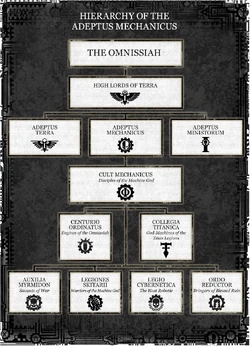
Imperial chart depicting the Hierarchy of the Adeptus Mechanicus
The following is an example illustration of the organisational structure of the Adeptus Mechanicus in the modern 41st Millennium:
- Omnissiah
- High Lords of Terra
- Adeptus Terra
- Adeptus Mechanicus
- Adeptus Ministorum
- Cult Mechanicus - Disciples of the Machine God
- Centurio Ordinatus - Engines of the Omnissiah
- Collegia Titanica - God-Machines of the Titan Legions
- Auxilia Myrmidon - Savants of War
- Legiones Skitarii - Warriors of the Machine God
- Legio Cybernetica - The Host Robotic
- Ordo Reductor - Bringers of Blessed Ruin
Holy Orders of the Cult Mechanicus
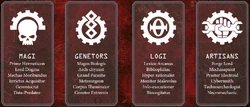
The Holy Orders of the Cult Mechanicus
The term "Tech-priest" covers thousands of different roles within the ranks of the Adeptus Mechanicus which are divided into several distinct holy orders. These include the following:
Magi
Magi (sing. Magos) of all stripes are senior Tech-priests with advanced specialisations in various disciplines of science and technology who pursue esoteric agendas as likely to end in triumph as they are disaster.
- Prime Hermeticon
- Lord Dogma
- Mechae Moribundus
- Invictus Acquisitor
- Gerontocraft
- Data-Predator
Genetors
Genetors probe the mysteries of the biological, creating ever stranger cyborgs or slaughtering xenos beyond number in order to excise yet more secrets of their alien metabolisms.
- Magos Biologis
- Arch-chymist
- Grand Parasite
- Metasurgeon
- Corpus Illuminator
- Genetor Extremis
Logi
A Logis (plu. Logi) is an analyst, statistician, and logistician whose purpose is to predict future trends and make forecasts about Mechanicus expenditures and needs. Because of their duties Logi are often regarded as prophetic figures within the Adeptus Mechanicus.
- Lexico Arcanus
- Bibliophiliac
- Hyper-rationalist
- Monitor Malevolus
- Info-executioner
- Biocogitatus
Artisans
Artisans create and restore truly wondrous weapons of war, from ornate Gamma Pistols to the mind-boggling immensity of the Ark Mechanicus. Also known as constructors, they design machines, buildings, spacecraft, weapons, and military hardware. They often oversee activity on Forge Worlds and control vast labor forces of Servitors.[1]
- Forge Lord
- Mechasapient
- Praetor Electroid
- Cybersmith
- Technoarcheologist
- Necromechanic
Rank Structure
The Cult Mechanicus is ordered by a strong hierarchy, but details on this hierarchy's actual make-up are not always clear. Generally, more highly positioned Tech-priests are expected to have more seniority and knowledge than lower ones, and are consequently more theologically important as greater repositories of knowledge.
Across the galaxy Transmechanics, Lexmechanics, Enginseers, Secutors, Cognitors, Trifactors, Myrmidons, Technoshamans, and more labour alongside the wider Imperium to bolster humanity's war machine.
Within the Adeptus Mechanicus the ranks become even more esoteric. A tentative mapping of this hierarchy, in order from highest to lowest, will follow below. It should be noted that specialists such as Genetors and Logis may not have any specific rank within the Cult as a group, but rather will be ranked as individuals.
Each Forge World is led by a Fabricator-General or other Archmagos with a similar rank but different title, and beneath them their Fabricator Locum. Each Fabricator Locum can call upon Magi Technicus, Metallurgicus, Alchemys, Cogitatrices, Pedanticum, Tech-assassins, hive monitors and Holy Requisitioners, who in turn can command a body of fabricators minoris, Fulgurites, Corpuscarii, overseers, underseers, stasis clerks, and techno-dervishes. Each sub-division within every facet of the order is split into dozens of ranks.
The Adeptus Mechanicus hierarchy (from highest-ranked to lowest-ranked) is as follows:
- Fabricator-General
- Magos
- Logis
- Genetor
- Artisan
- Electro-priest
- Enginseer
- Transmechanic
- Lexmechanic
- Runepriest
- Menials
- Servitors
The Adeptus Mechanicus also recognises the following specialist ranks, which stand outside the standard hierarchy of the Cult Mechanicus and usually serve a related military role for the Mechanicus or its allies amongst the other Imperial Adepta.
Amongst the most learned of Magi are those rare individuals who are considered tech-savants, a genius at the forefront of whatever field to which they turn their minds. Even amongst the ranks of the Adeptus Mechanicus -- where artificial devices increase brain capacity and extend life beyond measure -- such an accumulation of knowledge in multiple disciplines is exceedingly rare.
The Priesthood of Mars titles such beings as "Prime Conduits of the Omnissiah," or as Dominatus Dominus -- Master of Masters. On a Forge World, to avoid confusion during war, the most senior of the Tech-priests adopts the title of "Tech-priest Dominus" to lead the planet's military effort.
Titan crews and Space Marine Techmarines are listed last not because of their actual position within the hierarchy, but because of their relative separation from the rest of the Cult Mechanicus:
- Dominatus Dominus
- Tech-priest Dominus
- Collegia Titanicus Princeps
- Moderatus
- Tactical Officer
- Techmarine
- Skitarii
Fabricator General
The Fabricator-General of Mars is the highest-ranking individual within the Cult Mechanicus (in his capacity as the Magos Mechanicus), and administers not only the Adeptus Mechanicus but also governs the planet of Mars itself as the recognised Imperial Planetary Governor.
The Fabricator-General of Mars is the de facto leader of the Cult Mechanicus, and as befits his position, is awarded a permanent seat on the council that runs the Imperium, known as the Senatorum Imperialis or the High Lords of Terra.
Rulers of individual Forge Worlds are referred to as "Fabricator-Generals" as well, but only the Fabricator-General of Mars holds a seat amongst the High Lords of Terra, representing himself or herself as the leader of the Mechanicus as a whole.
Fabricator Locum
The Fabricator Locum is the second highest-ranking individual on the planet of Mars. The Fabricator Locum assists the Fabricator General with the governance of Mars, including the meeting of production quotas and ensuring the correct devotions to the Machine God are observed at all times.
The most notable Fabricator Locum was Kane who sided with the Emperor of Mankind during the Horus Heresy and thus maintained at least some crucial Mechanicus support for the Loyalists.
The position of Fabricator Locum, like that of Fabricator General, also refers generally to the second-highest-ranking Mechanicus official on any Forge World.
Magos
"There can be but one protocol to follow when faced with those who blaspheme against the Machine God. Begin the Canticles and send forth the Legions. The doom which we deliver must be absolute. All must fall before the Omnissiah's might."
- — Aurgreus Osmium, Tech-Priest Dominus
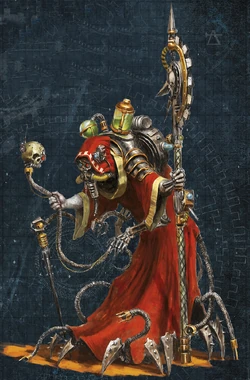
A Mars Tech-Priest Dominus
A Magos is a master of a technological or scientific discipline, having devoted many Terran years of service to the Omnissiah in that area of study. There are many specialist divisions within the Adeptus Mechanicus known as Divisiones.
Magi from these are given a rank containing the specialisation of their Divisio, such as Magos Alchemys, Magos Biologis, Magos Technicus, Magos Logis, Magos Xenologis, Magos Lexmechanicus, Magos Orbologis, Magos Cybernetica, Magos Xenobiologis, Magos Astrologicus, Magos Digitalis, Magos Fabricator, Magos Genetus, Magos Physic, and possibly many more.
There are two higher ranks within the Divisiones that are variations of the Magos, including Archmagos and Archmagos Veneratus. It is not known what the specific connotations of these titles are, though presumably they are indicative of greater seniority and experience.
- Magos Dominus: A Magos Dominus (fem: Magos Domina), known also as a Tech-priest Dominus, is a senior Tech-priest of the Adeptus Mechanicus who commands the Mechanicus' military forces and seek to advance military technology. The Magi of the Priesthood of Mars are the masters of much of what remains of the vast and potent military secrets of the Dark Age of Technology, particularly the ancient technology of combat robots, the Battle-Automata. To them the pursuit and preservation of the arcane mysteries of science and circuit are of far greater worth than petty wealth, worldly power or the lives of their fellow men. A Tech-priest Dominus may live for many standard centuries or even millennia, prolonging their life through arcane science and progressive cybernetic conversion, willingly becoming something other than human as they seek to fulfil the Omnissiah's will. The offices and titles of the Tech-priests are shifting and complex. Such is their authority that many senior Tech-priests adjust their ranks at will, in times of war adopting that of Tech-priest Dominus.
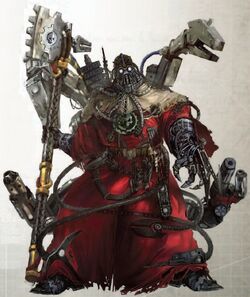
An Adeptus Mechanicus Magos Explorator
- Magos Explorator: Obsessed with the quest for knowledge, the senior Tech-priests who take on the mantle of a Magos Explorator search high and low across the galaxy for lost STC databases and ancient human scientific and technical knowledge lost during the Age of Strife. A breed apart from regular Tech-priests, any Explorator or member of his team will willingly walk into forgotten catacombs, even at the risk of death, for mere snippets of long-forgotten knowledge from the Dark Age of Technology. Many Magos Explorator command the Explorator fleets that continue to push outward the frontiers of the Imperium or even serve alongside Rogue Traders.
- Magos Errant: Something of a jack of all trades, a Magos Errant studies several scientific and engineering disciplines, including chemistry, genetics, metallurgy and more. They are then attached to Rogue Trader fleets and other similar Imperial expeditions by treaty between the Adeptus Mechanicus and the individual Rogue Trader houses or the Imperium itself if the expedition is sponsored by the Adeptus Administratum. In return for the Adeptus Mechanicus' expertise in technical maintenance and science, the Magos Errant is allowed to study interesting sites the expedition comes near, transport sensitive materials and generally make use of the expedition's resources for the greater good of the Machine God.
- Magos Juris: Magos Juris are those rare Tech-priests who choose to devote their minds to the study of the Machine God's will rather than the knowledge it embodies, removing themselves from the Quest for Knowledge in order to preserve it from the abuses of the heathen masses of Mankind. Amongst their colleagues on the Calixis Sector's Forge Worlds, these individuals are sometimes known as Magos Juris. They relentlessly pursue those who would commit tech-heresy or steal the secrets of the Adeptus Mechanicus. These Magos hunt down those who would employ unsanctioned technology or, even worse, operate technology without the blessing and oversight of the Adeptus Mechanicus. Magos Juris will go so far as to even take Mechanicus voidships into the depths of the Koronus Expanse to hunt down their foes. Worse still are those who smuggle technology, attempting to keep it from its rightful guardians. The fate of such men, when they are caught, is a grim one, for they are condemned to spend a far-expanded lifetime toiling without mind or will as a Servitor aboard the ship of the Magos that judged them, their minds obliterated and their bodies repurposed to serve the Machine God that they blasphemed against. There are many Explorator Tech-priests who speculate that the Magos Juris are, in fact, the agents of a secret order within the Adeptus Mechanicus known as the Lords Dragon. This ancient and powerful cabal is composed of specially-altered Archmagos said to exist deep within the secret inner circles of Mechanicus politics on the Calixian Forge Worlds known as the Lathes. Their task: to police the Mechanicus from within. However, little evidence can be found that proves the Lords Dragon exist at all, and that these Magos Juris do not simply operate on their own.
Logis
The accountants and mathematicians of the Mechanicus, the Logis are statisticians, analysts, actuaries and logisticians. They indirectly control a Forge World's resources.
They can accurately predict almost anything with very small margins of error, making them extremely useful to anyone with an artillery piece or seeking to determine interstellar trade flows.
Considered prophetic by some, the Logis are also very good at predicting future trends and forecasts and so they are often tasked by the Mechanicus with aiding the bureaucrats of the Administratum. Their dispassionate analysis is given great weight in decision making.
Genetor
Essentially geneticists, a Genetor is a Mechanicus scholar who studies all matters genetic and biological. Sometimes referred to as a "Magos Biologis," Genetors number alongside the Logis, Artisan and Magos ranks of the Adeptus Mechanicus as members of its ruling Priesthood, possessing access to knowledge and resources far beyond that of the lesser Enginseers and Lexmechanics.
A Genetor's field of study makes them distinct from the majority of Tech-priests, their professional obsession with organic life often making them seem strange to their more mechanically-inclined brethren. Their interest in the organic not only pertains to the human form, but to the study of xenos life as well.
The study of alien genetics, intended to better understand them and thus how to better slay them, falls to a sub-sect of Genetors collectively known as the "Xenobiologists."
Genetors are typically found accompanying Imperial or Rogue Trader expeditions to new or rediscovered worlds so that they can sample previously unknown species' DNA for its potential utility. Genetors also introduce common Imperial animals to a new colonial ecosystem, such as the Grox, a large reptilian animal that serves as a common food source on many Imperial worlds.
Artisan
Artisans are exactly what the name implies; they build and design pieces of technology for various purposes, from agriculture to war -- they are essentially the Adeptus Mechanicus' Corps of Engineers.
Usually found with an entourage of Servitors, these Adepts command labour forces that could rival small armies in size. They are responsible for controlling the vast labour force of Servitors employed by the Adeptus Mechanicus for all of their labour needs on any given Forge World.
Electro-priest
Electro-priests are techno-zealots devoted to the Cult Mechanicus, particularly the mysteries of energy, its flow through conductive bodies and the motivating spark, the sacred "Motive Force," it provides to Machine Spirits. They are known to be outfitted with a huge number of electoos.
Electro-priests support other Tech-priests in battle. The most fanatical Electro-priests are heavily cybernetically modified to permit them to generate electrical energy within their own bodies, transforming them into living fonts of crackling power, destroying everything they touch before collapsing from the strain.
Enginseers
Enginseers are the technicians of the Cult Mechanicus, specially trained in maintaining and repairing machines. They are often seconded to the Astra Militarum in order to maintain and repair the armoured vehicles used by the Imperial Guard's regiments.
Although most Guardsmen revere their vehicles enough not to risk annoying an Enginseer through "tinkering," some unique vehicles have been created from spare parts in time of need -- much to the chagrin of the Enginseers present.
Among their fellow Tech-priests, Enginseers are afforded little respect, as their labours do not normally contribute to the Quest for Knowledge because they only maintain existing machines instead of building or discovering new technologies.
Rather, they are viewed as lowly but essential cogs in the great machine that is the Cult Mechanicus. Most Enginseers have Mechadendrites attached to their back in order to facilitate their repair work.
Transmechanic
Transmechanics are technicians or service engineers who specialise in dealing with communications technology.
By the nature of their speciality, Transmechanics are often called upon to serve in other Imperial organisations for extended periods of time, and often spend their entire existence aboard Imperial Navy vessels or on Imperial Guard bastion-worlds.
Lexmechanic
Also known as "Calculus Logi," Lexmechanics are the librarians and scribes of the Mechanicus. Their purpose is to compile and rationalise data so it can be entered into a central Cogitator repository.
They can work with a computer's speed and accuracy, assembling battlefield reports, economic statistics, planetary reports, and so forth. Like Transmechanics, Lexmechanics are commonly assigned duties outside the Adeptus Mechanicus assisting the other organs of the Adeptus Terra.
Rune Priest
The Rune Priest's role is to inscribe runes and chant liturgies over machines as part of the Cult Mechanicus ritual of initiation.
They are trained in the most arcane branches of scientific lore such as intuitive mechanics, speculation, and improvisation. Rune Priests are famous for their lateral thinking, which may be called upon when strict logic and standard procedures fail.
Menials
As their name suggests, Menials are the menial and unaugmented human labourers of the Mechanicus, used primarily for unskilled labour too complex for Servitors to economically perform.
The billions of Menials are not considered true Tech-priests, but are usually indoctrinated with the beliefs of the Cult Mechanicus in a simplified form. Skitarii and, to some extent, new Tech-priests are often recruited from the ranks of the Menials on Mars and the other Forge Worlds.
Servitors
Servitors are mindless slave cyborgs, designed and programmed to perform menial, rudimentary or dangerous tasks for the Mechanicus and other elements of the Imperium like the Astra Militarum or even the Space Marine Chapters. There exists an endless variety of Servitors, from heavy mining Servitors to battlefield Gun-Servitors and elite Praetorian Servitors.
A Servitor's biological components are obtained either by growing genetically-engineered human bodies artificially in culture vats, or by using the lobotomised bodies of condemned Imperial criminals or failed prospective Space Marines -- all are subsequently augmented with mechanical limbs, computer uplink jacks and whatever electronic accessories are deemed necessary to facilitate their ordained tasks.
As they cannot think for themselves since their higher brain functions have all been disabled, they are essentially nothing more than partially-organic robots which use a portion of a human brain as their central processing unit. Some Servitors can be installed with combat programs which enable them to function as unswervingly loyal bodyguards.
On battlefields, they often form part of the retinues of Tech-priests, Techmarines and Inquisitors. These are seen as Gun-Servitors, bearing heavy weaponry; Combat-Servitors, armed with close-quarters combat equipment; and Technical Servitors, which are intended to perform repairs and construction duties instead of fighting.
Particularly large and heavily armed and armoured Servitors are referred to as Praetorian Servitors. Towering over even a Space Marine, Praetorian Servitors are created either from cybernetically-enhanced vat-grown genetically engineered giants or lobotomised Ogryns.
Adeptus Mechanicus Militant Ranks
Battle Congregation

An Adeptus Mechanicus Battle Congregation in combat
The war-processions of the Cult Mechanicus are thronged with living weapons, each eager to give vent to their lethal wrath. Such a gathering is a daunting sight, for it boasts a riot of cybernetic anatomies, and the monotonous cant that emanates from it plays upon the nerves like talons drawn down glass.
To witness an army of Tech-priests marching to war is to share the vision of an insane prophet. And yet beneath the curling incense and the grotesquerie of nightmarish anatomies, there is a structure that spans from one Forge World to the next.
The Tech-priest Dominus that commands each Cult Mechanicus congregation will typically call upon a body of Kataphron Battle Servitors to protect him. Though these living artillery pieces are potent indeed, they are easily replaced and can be mustered in the thousands if necessary.
All Forge Worlds create these half-machine war constructs on a daily basis, their biohangars stacked with rank upon rank of dormant Kataphron Servitors awaiting the binharic command to awaken. Their survival is of little import, and the Tech-priests will expend them with no more thought than a Space Marine would expend a clip of Bolter shells.
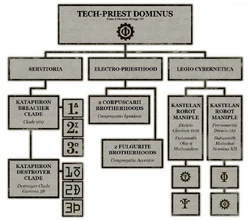
A typical Adeptus Mechanicus Battle Congregation consists of Servitors, Tech-priests and robots from a Forge World, united in their desire to see the enemies of the Machine God destroyed. The forces available to a Tech-priest Dominus are a reflection of his status in the labyrinthine hierarchy of the Cult Mechanicus. The example above is just one of a thousand iterations possible.
The same cannot be said of the Legio Cybernetica, for its automaton warriors are ancient and blessed in the Omnissiah's sight. When the use of these machines is sanctioned, they will usually be deployed en masse, organised into cohorts each consisting of four full-strength maniples.
Wherever these relics of Humanity's past march to war, they attract great numbers of the faithful, amongst them the fabled Electro-priests. These lightning-shrouded holy men trail after sacred machines in the manner of pilgrims and mendicants following the reliquaries of an Ecclesiarchal saint.
Theirs is the Motive Force, the third part of the Machine God's trinity, who gives the faithful the power they need to smite the unbeliever. In times of war these priests will raise a great chorus of praise to the Omnissiah, their weapons buzzing with murderous energy.
Such is the genius of the Cult Mechanicus' forefathers that their traditional war-psalms contain binharic strings of program and protocol. Each is sonically coded to enhance the Cult Mechanicus' warriors. Every Servitor, robot and priest has within him a subcutaneous electoo circuit that thrills with the glory of the Machine God, bolstering their strength when battle rages all around.
The Tech-priests put the resultant boost in efficacy down to the inspiring effects of faith, forgetting that each syllable contains enough binharic cant to rouse even the basest Servitor to a murderous wrath. Truly it is said that praise to the Machine God lends the faithful might enough to prevail; those that witness the electric rapture of a Cult Mechanicus procession in full flow are lucky to survive.
Skitarii
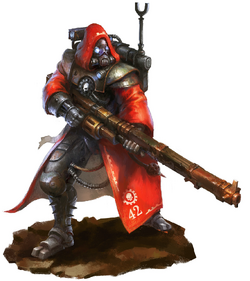
A Skitarii Ranger of Mars
The Skitarii are the cybernetic infantry forces of the Adeptus Mechanicus. Skitarii regiments that go to war alongside the Mechanicus' Titans are equipped with various esoteric weapons of war. Part man and part machine, most Skitarii are cybernetically-linked to their personal weapon for increased performance.
Skitarii are born into service either as natural-born human Menials of the Mechanicus who are cybernetically enhanced or in some cases as clones or vat-born humans who are cybernetically enhanced from the moment of their accelerated "birth."
Skitarii train with their weapon until they are of the age to be sent to a war zone. To guarantee their undying loyalty to the Mechanicus they usually undergo various forms of psychosurgery to wipe their minds of both emotion and personality.
The Skitarii do not simply crush their foes, but instead pitilessly blast them into bloody chunks of flesh. Even as they do so they record every tiny screed of battle data for later analysis. Just as the Skitarii exload the martial capabilities of the foe to their masters, the Tech-priests inload their own programs into the Skitarii.
It is usual practice for a legion's overseer Tech-priests to monitor each battle from a scryer-ship high above. Floating in a sea of data, each Adept sends battlefield commands down via data-tethers to the Skitarii on the planet below.
In this way their soldiers can be remotely augmented, used as eyepieces, forced into suicidal engagements, or even possessed entirely. The ever-devout Skitarii see these incidents as the divine spirit of the Omnissiah entering them and acting through them to the betterment of the Imperium. To the Tech-priests, their minions are little more than electric puppets jerking upon strings of pre-programmed impulse.
The Skitarii Legions do not fight alone, for they escort the vast goliaths of the Centurio Ordinatus to war, and even march in the shadow of the god-machines of the Titan Legions. It is the Skitarii that bolster the battle robots of the Legio Cybernetica and they who act as bodyguards for Tech-priests brave enough to take the field.
Skitarii are often also referred to as the Mechanicus' "Tech-Guard." Some Mechanicus factions recycle the organic portions of the bodies of dead Servitors and Skitarii as raw material for the formation of new vat-grown Servitors or Skitarii. The Crimson Guard rival any of the armed forces within the Calixis Sector.
Secutarii

Secutarii Hoplites and Peltasts working in conjunction with one another to protect a Battle Titan
The Secutarii Titan Guard were created as the honour guard and protectors of the Titan Legions, developed in the lost and ancient days long before the Imperium. For while a Battle Titan might shatter a mighty fortress or blast a tank company to ruin, it is the role of the Secutarii to eradicate such threats its survivors might still pose as the Titans press on to more important targets, and to hunt down and slay those who seek to flee from the Machine God's wrath.
Secutarii Hoplites go into battle armed with Arc Lances and Mag-inverter shields, weapons that enable them to hunt war machines and vehicles that would threaten their charges. Akin to the arc mauls of the Skitarii Clade officers, and the far larger of the mighty Cerastus Knight-Lancers, the arc lance inflicts damage through short range blasts of coruscating energy that can burn through xeno technology and render mute the machine spirit of even the most heavily armoured vehicle.
Mag-inverter shields provide the copious power needed by arc lances, and resists blows which would otherwise slay its bearer instantly through utilising a powerful and sophisticated inversion generator at the shield's core.
Their counterparts, the Secutarii Peltasts, seek targets of flesh and bone that would attempt harm on the great god-machines of the Collegia Titanicus. Armed with a Galvanic-caster, the Secutarii Peltasts are equipped for all manner of targets.
This electro-galvanically driven, multi-function projectile launcher has multiple firing modes that may fire rapid bursts of low velocity, razor-edged metallic flechettes; attack concealed targets with retina-burning ignis charges; fire an armour-piercing inert slug-shot at supersonic velocities; or even fire a barrage of blind canister shot to confuse and disorientate the enemy.
Classiarii
The Skitarii forces of the Adeptus Mechanicus take a variety of forms. On warships and Explorator vessels operating within the Koronus Expanse and the Calixis Sector, specially-programmed Skitarii are a necessity, for they serve as the members of boarding parties, security personnel and bodyguards where other forms of Skitarii would be impractical.
Within the Mechanicus territories of the Calixis Sector, these warriors are known as Classiarii, a term of obscure meaning within the ancient traditions of the Calixian Mechanicus, believed to mean "mariners."
Nigh-impervious to vacuum, fitted with thick, implanted armour, and equipped with an array of implanted weaponry designed for void combat and combat in the cramped enclosures of a starship, a Classiarius trooper is literally built for ship-to-ship combat.
Venatorii
The Venatorii were created in the wake of the War of Brass that devastated the Skitarii Legions of the Lathe Worlds, leaving entire Forge Worlds of the Calixis Sector with virtually no troops left.
The reigning High Fabricator started a discreet rearmament drive throughout the Calixian Forge Worlds. The more military minded Tech-priests were moved into position to help replenish the fighting ranks.
It took many Terran years to bring this grand plan together, but once everything was in place, the High Fabricator found himself with a new force consisting of some of the best-trained and best-equipped troops in the Calixis Sector.
Dubbed the Venatorii, the new hunters were a force that was to remain separate to the recovering Skitarii forces of the sector and act as the true elite of the Lathes. With their unique organisation and frightening red armour, the few outside of Mechanicus circles who were aware of their existence soon began to call them the Crimson Guard.
Techmarines
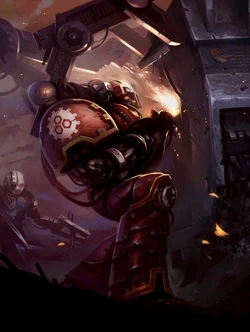
An Iron Hands Techmarine (known as an Iron Father) with a Servitor making a repairs on a vital piece of equipment.
Techmarines (or Fraters Astrotechnicus as they are known to the Mechanicus) are chosen from the ranks of the Space Marine Chapters for their technological aptitude. After being inducted into their Chapter they are sent to Mars for many standard years of training, and when they come back, they serve the same role with their Chapter as an Enginseer does with the Astra Militarum, maintaining and repairing their Chapter's weapons, equipment, vehicles and space vessels.
Although they are not officially part of the Adeptus Mechanicus, they are considered "honorary members" of the Mechanicus by both their Chapter and the Adeptus Mechanicus itself. Their Power Armour is modified to accommodate their cybernetic enhancements and their armour's back packs are upgraded with several servo arms or Mechadendrites.
Their armour is painted the rust red of the Adeptus Mechanicus, but their Chapter badge is retained and displayed on one of their shoulder plates, so as not to anger the Power Armour's Machine Spirit. Techmarines are able to wear full servo harnesses, which are huge harnesses armed with servo arms, Plasma Cutters, and Flamers.
They are commonly accompanied by a full retinue of Servitors, including Gun Servitors, Combat Servitors, and Tech Servitors. They bear a Power Axe with the Adeptus Mechanicus Cog Mechanicum sigil on the head, as both a symbol of their office and as a weapon.
- Iron Fathers - The Iron Hands Space Marine Chapter has closer ties to the Adeptus Mechanicus than is normal for the Adeptus Astartes, and like the Mechanicus their Astartes consider flesh to be weak, while cybernetic implants are more spiritually pure. The Iron Father fulfills the role of a Techmarine, a Chaplain and an officer in an Iron Hands company.
- Iron Priests - The Iron Priest is the Space Wolves' equivalent of the Techmarine. Iron Priests look after the many technical systems in the Space Wolves' fortress-monastery on the world of Fenris, The Fang. They supervise engineering projects and all the other complex technical tasks undertaken every day. The skills of these grim and taciturn artisans are both respected and feared by their fellow Space Wolves, most of whom view the mechanical and scientific arts as a dark and frighteningly arcane sorcery.
Adeptus Mechanicus Minoris Ranks
Amongst the standard ranks of the Tech-priests there can be found several minor orders of Tech-adepts who are dedicated to more specialised functions. These Tech-priests are considered to belong to what are known as Minoris ranks within the larger, overall hierarchy of the Cult of the Machine. Some Minoris ranks include:
Acuitor Mech-Assassin
An Acuitor Mech-Assassin is part of an order of Adeptus Mechanicus, located within the Lathes in the Calixis Sector, that are dedicated to the art of death. They are only answerable to the Magisters Samadhi of their own order, and usually move according to their masters' will without scrutiny. The Acuity Set of the Lathes, less formally called the Mech-Assassins, are trained in the art of stealth, able to move within plain sight amongst the lay folk throughout the sector, hidden from scrutiny beneath heavy red robes.
These executioners are pulled from across the Lathes and beyond, and instructed in secret fortresses scattered throughout the Calixis Secotr. Most candidates who are chosen have proven both faithful and capable of using the skills of the Adeptus Mechanicus to deadly effect. Through the mentally recorded data-tracts left by their founder, Magos Samadhi, the Mech-Assassins believe these cogitations guide them to the targets of their wrath and aid them in making short work of those who oppose the Lathes.
Reclaimator
The most-skilled and certainly least trusted of the Adeptus Mechanicus functionaries are the Reclaimators. It is their task to redeem raw materials from old and damaged systems, to scavenge parts and be tasked with the endless cycle of minor repairs needed to keep a starship flying or a hive's infrastructure from collapsing under its own weight. By necessity, a Reclaimator's skills begin to stray into a higher understanding of machinery and technology than most and many learn to worship the Machine God in a fragmentary and superstitious manner, marking them apart from others of the Mechanicus.
Reclaimators themselves are often sent into dangerous or unsafe areas with little direct supervision, and they scavenge and salvage a good deal more than their masters know. As a result, most Reclaimators have a well-deserved reputation as suspicious, shifty characters who sell their skills and the items they retrieve or repair for a good profit on the black market. Many have links to criminal gangs and more than a few are willing to resort to robbery and even murder to build up their spoils if they think they can get away with it.
Secutor
Some Tech-priests are drawn to the path of the Secutor through a fascination with the unique and intellectual challenges warfare provides, while others feel themselves drawn to the intricacies and beauties of creation and destruction, or the sacred art of weaponsmithing. Others simply see this path as a means to an end, either for the protection of the Machine Cult, the furtherance of their own independent researches, or some other, hidden agenda.
Regardless of the reason for their vocation, a Tech-priest skilled in such destructive arts as the Secutor is an invaluable ally for an Inquisitor, and makes for a singularly lethal Acolyte. The only downside to such an association is that the Inquisition can never be fully sure where the Tech-priest Secutor’s loyalties lie -- even more so than others of their kind -- or what ancient and dark secrets they may themselves possess.
Techsorcist
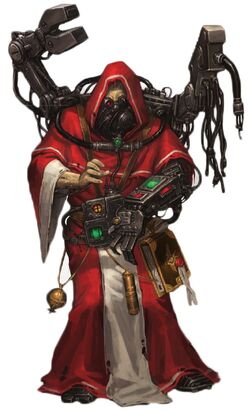
Created by Magos Eremor in the latter half of the 36th Millennium in response to the reappearance from the Warp of the Space Hulk Fatum Posterus, within the Calixis Sector the Techsorcists have long been on the frontlines whenever heretical technology has been found. Some Forge World Tech-priests develop an interest in analyzing corrupted Machine Spirits. Unusually for Tech-priests, Techsorcists are capable of intuitive thinking, speculation, and improvisation, and are famous for their lateral and often unorthodox process when strict logic and standard procedures fail.
This is an invaluable tool for an Inquisitor trying to understand his foe's weaknesses. In the service of the Inquisition, a Techsorcist performs all the typical tasks of a Tech-priest, but has a deeper understanding of how Chaos mutates and adapts technology. Within the Calixis Sector the ranks of Techsorcists have swelled as the demand for trained daemon-hunting Tech-priests has grown. A trained Techsoricist, if not several, are in the employ of nearly every Ordo Malleus Inquisitor in the sector.
Adeptus Mechanicus Divisions
Collegia Titanica
The Collegia Titanica is the division of the Adeptus Mechanicus that commands the Titans -- colossal robotic combat walkers which are the most potent ground weapons capable of being deployed by the Imperium. The Collegia was one of the groups of the Adeptus Mechanicus that went over to the Warmaster Horus Lupercal almost en masse alongside the Legio Cybernetica during the Horus Heresy. The name "Adeptus Titanicus" is also used for the corps of Titans fielded by the Mechanicus.
The Collegia is subdivided into organisations called "divisiones," such as the Divisio Militaris, Divisio Mandati, Divisio Telepathica and the Divisio Investigatus. The most important of these divisions is the Divisio Militaris since it actually includes the Battle Titans, and is itself further divided into the Titan Legions or Titan Orders: groupings of Titans such as the Traitor Death's Head Legion, the Fire Wasps Legion or War Griffons Legion. Each Titan Legion is commanded by an officer known as the "grandmaster" who may also be the princeps of the most powerful Titan in the Legion.
Each Titan is manned by a crew consisting of a single princeps in command of the Titan, assisted by varying numbers of Moderati, Sensori, Steersmen, Tech-priests, Enginseers, and Servitors. The number of each is dependent on the type of Titan.
- Princeps - The training of a princeps begins at an early age and ends with eight years at the Collegiate Titanica on Mars. The cadets receive their uniforms and cybernetic MIU implants in the final year, before field-training starts with an attachment to a currently-operating Titan for observational tours. A princeps commands their Titan through an MIU's (Mind Impulse Unit, see above) cybernetic link to the Titan's artificial intelligence or "Machine Spirit", controlling both their crew's actions and the Titan's movements through their thoughts. The Titan becomes an extension of its princeps; when it is damaged, they feel pain, when victorious, they feel elation. This link grows so strong that the princeps' mental health will slowly deteriorate when unlinked from the machine. They can assume direct control of any system, though it is usually aiming and fire control that is taken. In a Warlord or Imperator-class Titan the princeps is sometimes placed in an amniotic casket to provide full sensory immersion in order to control the truly massive Titan without difficulty. Regardless, Titans must have both a princeps and a command crew to function. The princeps' relation to the Titan is similar to that of a Space Marine within a Dreadnought cybernetic shell. However, Titans are capable of eventually developing their own sentient minds from centuries of experience. The cybernetic link in some cases gets so strong that the princeps becomes neurologically integrated with the Titan, and cannot be removed until they die of natural causes. A princeps who commands a Legion of Titans is ranked as a "princeps maximus" or "grandmaster", though an entire Legion of Titans has very rarely been fielded since the Horus Heresy.
- Moderati (sing. Moderatus) - The moderati are the officers who comprise the command crew of a Titan that take the princeps' orders and act on them, monitoring the Titan's auspices and scanners, firing the weapons and making sure all systems are functioning normally. Although they also have MIU links to the Titan like the princeps, they cannot assume command nor can they interface directly with the princeps' own dominant neural link, instead using their links solely to provide information about the Titan's state in battle.
- Sensori (sing. Sensorus) - The third-ranking member of the bridge command crew, the sensori is the Titan's Tactical Officer and controls and monitors all the sensory inputs of a Titan, from the aural sensors to the simple visual inputs. It is also their job to spot and acquire targets for the moderati (or princeps) to engage. They also deal with all Titan communications, decrypting or relaying vox messages to the princeps' display screen on their command throne as necessary.
- Steersman - The fourth member of a Titan's bridge crew, the steersman controls the Titan's stability and is essentially the driver of the Titan.
Knight Houses
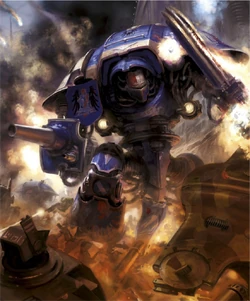
An Imperial Knight Paladin in battle
Thousands of standard years before the rise of the Imperium, Mankind reached out to the stars and settled many far away worlds. Among the apparatus of colonisation were formidable war machines known as Imperial Knights, which existed to protect the settlers from any threat. These small combat walkers are one-man versions of a Titan. However, a Knight is smaller and less capable in combat than even the smallest class of true Titan utilised by the Titan Legions, the Warhound-class Scout Titan. Knights normally deploy in squadrons comprised of several of these war machines. These ancient battlesuits stand thirty to forty feet tall, are protected by nearly impenetrable Ion Shields and armed with a devastating array of heavy weapons. Imperial Knights are colossal war machines that tower over the battlefield.
The strongholds constructed from the remains of ancient Terran colony starships are ruled by the descendants of the first human settlers of those far-flung worlds, mighty warriors who enter combat in their towering armoured battlesuits and who are sworn to protect and guard the Imperial citizens who inhabit their worlds. The descendants of the early pioneers who settled their respective worlds were found in the knightly houses of the Imperial Knights.
Known formally as the Questoris Familia, these dynasties of Imperial nobility evolved from the need to protect the early human settlers of the Knight Worlds from indigenous species discovered on their alien planets. These proud and haughty warriors can trace their bloodlines back to Terra itself and are known as nobles. Over the millennia, the pilots of these massive war suits have established a rich culture, with noble houses each sworn to the defence of their homeworld, and bound by oaths of fealty to the Golden Throne of Terra and the Adeptus Mechanicus of Mars.
Centurio Ordinatus
The Centurio Ordinatus, a section of the Mechanicus' Divisio Militaris, is the Adeptus Mechanicus organisation responsible for the development, maintenance and operation of the mighty Ordinatus war machines. Every individual Ordinatus is a unique construction and named for the Imperial world on which it was first employed or built.
Each Ordinatus is a unique weapon that is designed for a specific purpose or for a particular battle. This explains why the Ordninatii Tech-priests that operate these massive war machines of the Machine God are configured using special augmetics to aid their intended purpose.
Legio Cybernetica
The Legio Cybernetica is one of the oldest sub-branches of the Adeptus Mechanicus and is responsible for deploying fully autonomous robots for both combat duties and support tasks intended to aid Imperial armed forces in the field. The Legio Cybernetica can trace its lineage the time before the birth of the Imperium of Man when Mars was the capital of an independent interstellar empire ruled by the Tech-priests of the Cult Mechanicus. Its members regard themselves as an elite within the ranks of the Mechanicus, as they have a long history of serving the will of the Emperor of Mankind.
However, many of those within the Legio broke faith with the Emperor during the Schism of Mars, siding with the traitorous forces of the Warmaster Horus and fighting alongside his Traitor Legions throughout the Horus Heresy. When this conflict ended, the Traitor cohorts of the Legio Cybernetica fled into the Eye of Terror, where they remain to this day, warped and twisted by their exposure to the power of Chaos.
The remaining Loyalist elements of the Legio Cybernetica pledged themselves anew to the Imperium and its members took binding oaths of loyalty more terrible than any taken even by the Astartes. Over the millennia since the Heresy, the Legio Cybernetica has regained the respect and admiration of the rest of the Adeptus Mechanicus as well as the other myriad Adepta of the Imperium.
Collegiate Extremis
The Collegiate Extremis is the judicial branch of the Adeptus Mechanicus. It is similar to the Adeptus Arbites in function: traitors to the Omnissiah are prosecuted and their crimes analysed. At its head is the Lords Dragon, an ancient cabal orchestrating the Collegiate, perhaps of Archmagi Veneratus of whatever divisiones of the Mechanicus serve in the Collegiate.
The main leaders of the Collegiate Extremis would, in theory, be on Mars, and each Forge World would have a Lord Dragon of its own to command the local members of the collegiate, but this is based on circumstantial evidence. The Collegiate's will is enforced on Forge Worlds by attached Skitarii Provosts, as they are known, and the Magos Juris carry out their will across the galaxy. In many ways the Collegiate Extremis serves as the Mechanicus' own internal variant of the Imperial Inquisition.
Auxilia Myrmidon
Within the Calixis Sector, the undisputed centre of power within the Lathe System is the Auxilia Myrmidon, a seeming sub-organisation of the Skitarii Legions, composed of elite Tech-priests known commonly as the Siege Engineers or the War Savants. This Mechanicus sect exists to study the art of destruction with the ardent fervour that their fellows mighty apply to the creation of machinery or the recovering of lost archeotech.
Legend has it they came to the sector during the earliest days of the Angevin Crusade (322-384.M39) for reasons of their own, and have since remained to defend the Cult Mechanicus’ possessions there. Myrmidons are expert killers, weapon masters and destroyers. At the behest of the ruling Archmagos of the Forge Worlds, they are sent to accompany Explorators in investigating finds in the most dangerous sectors of space and retrieve the most hazardous xenos-specimens, whilst others are tasked to hunt down Mechanicus Renegades accused of the foulest techno-heresies and terminate them with extreme prejudice.
A Secutor is the first rank in the Auxilia Myrmidon presumably as the standard trooper, and is also the first Adepts Minoris rank in the Divisio Mandati. other members of the sect operate their vehicles as drivers, known as Myrmidons, who also serve in the Ordo Reductor. A platoon leader of a unit of Secutors or Myrmidons is known as a Centurius. A Tribune (commonly known as a lieutenant in the stand Imperial armed forces) commands a century; a Magnus (also known as a captain, and perhaps an Adept Majoris) commands a cohort, with a Colonel-priest having control of a battalion and a Magos Commander in charge of an entire Legion of the Auxilia Myrmidon.
Divine Light of Sollex
The Auxilia Myrmidon is not the only militant Mechanicus faction in the Calixis Sector, and since the 8th century of the 41st Millennium a highly mystical tech-sect based at the forge facilities on the Death World of Haddrak in the northern rim of the Adrantis Nebula has grown to prominence and increasing power.
The Divine Light of Sollex, as they call themselves, are zealots in the Machine God’s cause, as coldly fanatic and savage in their way as any Redemptionist of the Imperial Creed. To them, the preservation of the arcane mysteries of the Machine Cult from those who would misuse them are of far greater worth than petty wealth, worldly power or the lives of their fellow men, or even other members of the Cult Mechanicus.
Disciples of Thule
The Disciples of Thule are another sect of the Cult of the Machine that operates out of the Calixis Sector. Their overall spiritual leader and guide is the Archmagos Paracelsus Thule. Many centuries old, Thule's fleet, which disappears out beyond the edge of Mankind's domain for solar decades at a time, is vast and many Explorator Adepts and Magos have served under his tutelage over the years, passing on his teachings to their juniors in turn.
Thule's instruction centres on identifying pre-Imperial human technologies and sets the goal of finding the relics of Mankind’s glorious past above all other concerns and risks. This lack of caution makes Thule and those following him something of a radical faction within the Cult Mechanicus, but a powerful and influential one in the Calixis Sector.
Thule's disciples centre their studies entirely on analysis and investigation, valuing the acquisition of knowledge above all other concerns. They disdain physical confrontation and are often so wrapped up in cogitation they fail to notice what is in front of them. Some Inquisitors appreciate this curiosity in their Tech-priests, finding it preferable to the narrow thinking and conservatism many others of their kind demonstrate, even though curiosity almost always carries its own dangers.
Ordo Reductor
The Ordo Reductor is a sub-organisation of the Adeptus Mechanicus that developes, manufactures and operates siege weaponry. There is a sizable portion of the Ordo Reductor staffed primarily by Myrmidons of the Auxilia Myrmidon. It is claimed that these Myrmidons are located on the Mechanicus fiefdom in the Calixis Sector known as The Lathes; the Myrmidons are masters of the mysterious Ordo Reductor, and are said to be towering and fearful figures decked out in blood-red and black robes, bearing the forbidden weapons of a bygone age.
Even wilder legends speak of this place as the home of mech-assassin covenants and the dread Magister Samadhi -- beings whom most Magos consider no more than a dark myth. Some even speculate that the Panopticon's rulers are members of a secret order known as the Lords Dragon, an ancient and powerful cabal of Archmagos tasked with policing the Mechanicus itself.
Duties Within the Imperium
Besides scientific research and maintaining the Imperium's machines, there are many important duties that the Adeptus Mechanicus performs in order to keep the Imperium of Man functioning on a day-to-day basis. These include:
- Caretakers of the Generatorium: The advanced technology of the Imperium requires power and this power is supplied by Generatoriums, large, nuclear fusion-based power plants. The creation and operation of the Generatoriums (power plants) containing the Generatorium are the function of the Adeptus Mechanicus and the information behind their operations and construction are closely guarded from outsiders.
- Caretakers of the Genetorium: Like the Generatorium, the Genetorium is vital to a planet's survivability. The Genetoriums provide a list of all plants and animals that are either on a planet or will be introduced to the planet to make it habitable by Mankind. A Genetorium is normally run by a Magos Biologis and plays a vital role in the Inquisition's activities. Their duties also extend to searching for genetic impurities in baseline human populations and in the hunting down of dangerous human mutants like rogue psykers.
- Caretakers of the Librarium: All of the knowledge in the Imperium is stored in the vast Librariums of Terra and Mars. Along with the Administratum, the Tech-priests store, guard, and reproduce what knowledge they can attain. In the Age of the Imperium where stagnation is the rule, knowledge has truly become power.
- Caretakers of the Manufactorium: As with the Librariums, the Tech-priests administer and protect the manufactoriums of the Forge Worlds that ensure that the Imperium is provided with the goods and machines that ensure its survival.
- Caretakers of the Astartes: All Space Marine Chapters are expected to pay a tithe of 5% of their gene-seed every year to the Adeptus Mechanicus so that the Mechanicus' Tech-priests can monitor the health of each Chapter and facilitate the Founding of new Chapters from existing gene-seed lines whenever the High Lords of Terra decree that the Imperium has a need for new Chapters of the Adeptus Astartes.
The Inquisition and the Adeptus Mechanicus
The servants of the Machine God exist as a nigh-autonomous class within the multitude of the Emperor's servants. They consider themselves outside many of the laws that govern most of Humanity, and they openly deny many of the teachings of the Ecclesiarchy.
Despite the fact that this vast, ancient and highly secretive organisation appears to openly reject the mores of the Imperium, it is still ubiquitous across the galaxy. The reason for this is that the Imperium simply could not function without the Priesthood of Mars -- all of Mankind's accomplishments would crumble and fall within a generation were the Tech-priests not to maintain them. Without the Mechanicus, no starship would ply the void, no army march to war, no raw material be refined and nothing more than a stone hovel be constructed.
The Adeptus Mechanicus can at times prove a divisive organisation, for its members care little for the sensitivities of others. They engage in a faith entirely alien to the followers of the Imperial Creed, speak in a language that bears little resemblance to High Gothic or of any planetary dialect, and appear outlandish, even by the diverse standards of a culture as heterogeneous as the Imperium. Furthermore, the tenets of the Tech-priests' faith revolve around communion with and adoration of the machine, a concept many God-Emperor-fearing people find deeply unsettling, or outright abhorrent.
The mission of the Adepts of the Omnissiah is the Quest for Knowledge, the gathering of all of the wisdom lost during the distant Age of Strife. The Tech-priests know that Mankind has forgotten far more of technology than remains intact, and so fight a constant battle to maintain the machines on which so much of Humanity relies.
Yet, this is a losing battle, for with each generation understanding gives way to superstition, and it is this inexorable descent to barbarity the servants of the Machine God strive to avert. In their quest to prevent this descent, the Tech-priests delve into long-sealed repositories of lost technology, unearth god-machines long buried beneath the ashes of forgotten battlefields, and decode the ciphers of reality itself.
There are plenty within the Inquisition, as well as other Imperial institutions, that believe the Adeptus Mechanicus walks a fine line between duty and damnation, and take it upon themselves to combat a threat they perceive to be as terrible as any posed by alien or daemon.
There are uncounted records of confrontation between Inquisitors and members of the Adeptus Mechanicus. To date, such battles have largely been confined to small skirmishes fought between bitter rivals, and have rarely flared up into open conflict between larger numbers of either organisation.
Indeed, the Inquisition relies upon the services of the Adeptus Mechanicus as much as any other Imperial organisation, and so great pains are often taken to ensure personal conflict between individual Inquisitors and Tech-priests does not escalate into something more damaging. Despite this, many within the Inquisition resent the autonomous attitudes of the Adeptus Mechanicus, while many Tech-priests begrudge interference from the Inquisition.
There are times when an Inquisitor is forced to request the aid of the Adeptus Mechanicus, perhaps in the investigation of a matter so specialised only a Tech-priest has the requisite knowledge and skills. At other times, the Inquisitor may have need of the considerable military forces of the Adeptus Mechanicus, perhaps in the form of the mighty Titan Legions.
An individual Inquisitor approaching the Adeptus Mechanicus might have little chance of gaining such aid, but with the help of an individual Tech-priest, may find that doors are opened. For this, and other reasons, many Inquisitors foster mutually beneficial alliances with Tech-priests with whom they have worked in the past, often employing them on their staff of Acolytes.
Few within the Adeptus Mechanicus consider themselves oath-bound to such an Inquisitor, for their loyalty ultimately lies with the Omnissiah. Nonetheless, such an alliance can prove highly agreeable to both parties when the mission of the Inquisition and the Adeptus Mechanicus converge.
Videos
Sources
- Codex: Adeptus Mechanicus (8th Edition), pp. 10, 12-13, 19, 32-35, 44
- Codex: Adeptus Mechanicus - Cult Mechanicus (7th Edition) (Digital Edition), "Priesthood of Mars," "The Cult Mechanicus," "The Blessed Priests of the Omnissiah," "Processions of the Faithful," "Cult Mechanicus Battle Congregation," "The Quest for Knowledge," "Weapons of Enlightenment"
- Citadel Journal 21, "Adeptus Mechanicus Detachments: Skitarii Tech-Guard of the Forge Worlds", pp. 5-9
- Codex Imperialis (2nd Edition), pp. 41-42
- Dark Heresy: Ascension (RPG), pp. 178-179
- Dark Heresy: Blood of Martyrs (RPG), pg. 57
- Dark Heresy: Core Rulebook (RPG)
- Dark Heresy: Daemon Hunter (RPG), pp. 58-59
- Dark Heresy: Inquisitor's Handbook (RPG), pp. 68-70
- Dark Heresy: The Lathe Worlds (RPG)
- Fanatic Magazine 5
- Horus Heresy: Collected Visions (Art Book), pp. 92, 131, 304, 326, 328, 384, 392, 402, 405, 412
- Realm of Chaos: The Lost and the Damned (1st Edition), pg. 169
- Realm of Chaos: Slaves to Darkness (1st Edition), pg. 240
- Rogue Trader: Hostile Acquisition (RPG), pp. 85-88
- Rogue Trader: Into the Storm (RPG), pp. 82-83
- Titan Legions: Codex Titanicus, pp. 9-16
- Warhammer 40,000 Codex Imperialis (2nd Edition)
- Warhammer 40,000 Compendium (1st Edition), "Chapter Approved: Dreadnoughts," "Chapter Approved: Imperial Robots," pp. 56-61, 67, 96-112
- Warhammer 40,000: Rulebook (8th Edition), pp. 25, 27, 33, 37, 56, 71-75, 86, 155, 278-280
- Warhammer 40,000: Rulebook (7th Edition)
- Warhammer 40,000: Rulebook (6th Edition), pp. 138, 146, 158, 170, 386, 402-403, 405
- Warhammer 40,000: Rulebook (5th Edition), pp. 106, 110-111, 124-125
- Warhammer 40,000: Rulebook (4th Edition), pp. 120-121
- White Dwarf 308 (US), "Priests of Mars", pg. 84
- White Dwarf 191 (US), "Ordinatus: Imperium - The Adeptus Mechanicus", pp. 49-53
- White Dwarf 178 (US), "The Titan Legions: History, The Adeptus Mechanicus - The Birth of the Cult Mechanicus", pp. 45-52
- White Dwarf 140 (US), "Space Fleet: Adeptus Mechanicus", pp. 46-75
- White Dwarf 104 (UK), "Chapter Approved: Imperial Robots," by by Mike Brunton
- Xenology (Background Book)
- Mechanicum (Novel) by Graham McNeill
- Dark Adeptus (Novel) by Ben Counter
- Dark Apostle (Novel) by Anthony Reynolds
- Helsreach (Novel) by Aaron Dembski-Bowden
- Iron Hands (Novel) by Jonathan Green, pg. 122
- Titan (Novel) by Dan Abnett, Anthony Williams and Andy Lanning
- Priests of Mars (Novel) by Graham McNeill
- Adeptus Titanicus - The Horus Heresy: Rulebook (Specialty Game), pp. 14-17
- Battlefleet Gothic Armada II (PC Game) (Image)





